|
Monday, April 27, 2009
Progress Notes
A month ago on March 23 I presented the Tylers’ of Miller County with an emphasis on the Barney Tyler family (photo 01).
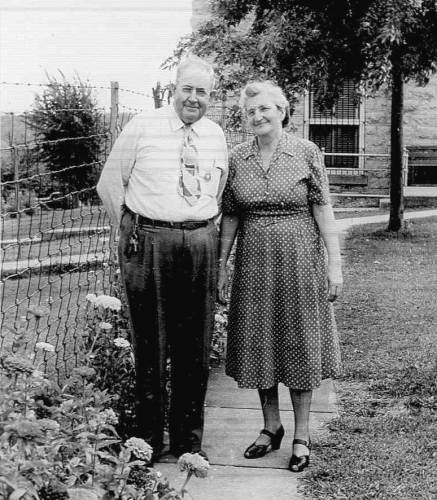
01 Barney and Minnie Tyler One of the stories included in that narrative was about the tragic heroic death of Barney’s son, Ace Tyler, Army Air Force pilot, who was shot down over Germany in 1943. Ace’s brother, Bob Tyler, just a few years ago completed a very well researched accounting of that event from which he composed a very interesting and gripping narrative (photo 02).
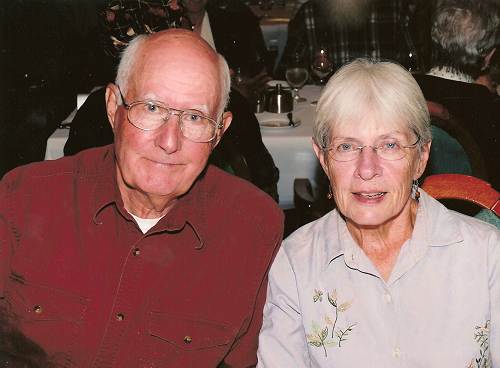
02 Bob and Alice Tyler Bob had told me a couple of years ago he was in the process of compiling the data from his research after which he planned to author the story for the purpose of informing relatives and friends of just what it was like to have been a World War II pilot facing intense enemy fire while trying to complete a bombing mission. Bob gathered data from files obtained from the Department of Defense which up until recently had been closed to the public. He also made a trip to Germany to visit the exact site of the crash of Ace’s B-24 bomber and to talk with individuals still living who witnessed the plane come down in flames.
Recently, Bob sent me a copy of his story about Ace. It is fairly long but I found it so interesting I read it all at one sitting. Bob also included quite a few informative photos including shots of the airplanes used during the air war in Europe as well as interesting detail on how they were constructed. I thought this week I would put the entire narrative on our website rather than serialize it because I think it is more interesting and meaningful to read at one time in its entirety.
The story is a wonderful tribute to the heroic efforts of Ace and his fellow pilots. I was greatly impressed by the brave sacrifice of so many American soldiers and airmen who were fighting so bravely to the point of death to save Europe from its own destruction. How this story of sacrifice and unselfishness contrasts with the image Europeans want to portray we Americans today; how soon they forget!
I believe many of you will find the narrative very informative and more than that, reinforces the belief that many of the most courageous, heroic and capable young men our country ever produced were lost in this selfless effort to save Europe from the despotism of Nazism.
ACE’S STORY
Robert W. Tyler
2009
FOREWARD
When I was an early teenager in 1944, my oldest brother, Ace, was a hero to me. Now, almost sixty-five years later, and after doing the research for this story, he has become even more a hero. Through the years, I and my family often were curious about Ace’s war experiences. We had only a small amount of knowledge about his last mission and how he died. This was that he and eight others of his crew of ten were killed on a mission to Politz on May 29, 1944. One crew member, the navigator, had parachuted to safety and taken a prisoner. The lack of information was largely due to censorship of communications. Obviously, many questions were raised in my mind about this difficult time in the family history. So after I retired, I began to try to find some answers. A few years earlier, information in the National Archives about the military had become declassified and available to the public. Unfortunately, many military personnel records housed in St. Louis, Missouri were destroyed in a fire in the early 1970s. These included records of Ace. The information gathered for this story which follows comes mainly from two sources. One valuable source was the many letters written from Ace to other family members, largely to Homer, his brother, and to Mary Jo, his wife. Of course very little, if any, secretive information could be included in the letters. After his training and when he became a pilot with a crew, Ace was responsible for reading and censoring letters of other crew members. Obviously, he was very careful not to include anything sensitive in his own letters. The other major source was the military records housed in the National Archives and other Government Agencies.
The organization of the story is divided into a chronological order of events. After some family background information is given, the different phases of air cadet training are covered. Then the period of preparation for combat is followed by the actual combat missions which occurred in the Spring of 1944. The time after the word of his Missing in Action is obviously a time of hope, and when the confirmation of his death arrives, it becomes a time of mourning and reaching out to others in the crew families. Other parts include: information gathered in the search for family members of the crew; details about our visit to Wendling Air Base in England; and the trip to the site of the fatal crash in Germany.
Several acknowledgements need to be made in regard to completing this work. First, to Ace’s wife, Mary Jo. She talked with me and encouraged me in my work and provided me with many letters, pictures, and other materials which were very important. Then after her death in 2002, her brother, Jud turned over to me her saved documents, pictures, etc. Homer had also saved many letters that he had received from Ace. After Homer’s death in 1994, his wife Lou had given boxes of these letters to Alta and she gave them to me. These were very important in following the training phases of Ace’s military career.
I would also like to acknowledge the assistance given to me in my research at the National Archives. Ben Jones, a researcher for the B24.net web site really got me started in the research at the Archives. (The B24.net web site is dedicated to the 392nd Bomb Group and is a rich source of information). Ben grew up near the Wendling Air Base in England and was always interested in the history of the 392nd Bomb Group. Another researcher of the web site, Annette Tison, has been very helpful in pointing out sources and making suggestions. Many hours have been spent in talking with her about the 392nd. Her uncle was killed in the April 29, 1944 mission to Berlin.
Many others have given me valuable assistance in my endeavors. Jim Marstellar and Carsten Kohlmann were very helpful in organizing the trip to Germany. Jim is active in the 392nd memorial group and was instrumental in getting me in touch with Carsten. Carsten is a military historian in Germany and helped locate a contact who lives and works in Burow, which is close to the crash site of Gueltz. This contact was Ilona Hausler. She served as our guide and translator during our visit to the crash site in 2003.
I would also like to give thanks to Don, my brother, and Alta, my sister, who gave me encouragement and motivation to continue this project. Ronnie Cross, my nephew, was also important to me in the development of this story. He looked at my information and read earlier versions, giving me valuable suggestions. Finally, I would like to acknowledge my wife Alice and her encouragement. She also was my partner in the ventures to places in Europe and this country to learn more about the details in this story. She shared and understood my tears as I relived the memories.
When I read the many letters of Ace’s, it became obvious to me that early in his training he developed a real love for flying. He wrote of the feeling of putting the plane through the many maneuvers they had to learn and how exhilarating it was for him. I have chosen to insert here a poem which possibly became the most famous to come out of World War II. I think it reflects many of the feelings a flyer has. It was written by a young American flyer who had enlisted in the Royal Canadian Air Force and sent to England to fly for them in the early days of the war with Germany. His name was John Gillespie Magee and he flew a Spitfire on a test flight where he flew as high as 30,000 feet. When he landed he wrote to his parents in America and said, “Am enclosing a verse I wrote the other day. It started at 30,000 feet, and was finished soon after I landed.” On the back of the letter he had scribbled what was to become the most famous aviation poem of the war: “High Flight.”
|
Oh! I have slipped the surly bonds of earth
And danced the skies on laughter-silvered wings;
Sunward I’ve climbed, and joined the tumbling mirth
Of sun-split clouds-and done a hundred things
You have not dreamed of-wheeled and soared and swung
Hung in the sunlit silence. Hov’ring there,
I’ve chased the shouting wind along, and flung
My eager craft through footless halls of air.
Up, up the long, delirious, burning blue
I’ve topped the wind-swept heights with easy grace
Where never lark, or even eagle flew-
And, while with silent lifting mind I’ve trod
The high untrespassed sanctity of space,
Put out my hand, and touched the face of God.
|
A few months after this, Magee was killed in a midair collision on a training mission not far from where he had written his poem.
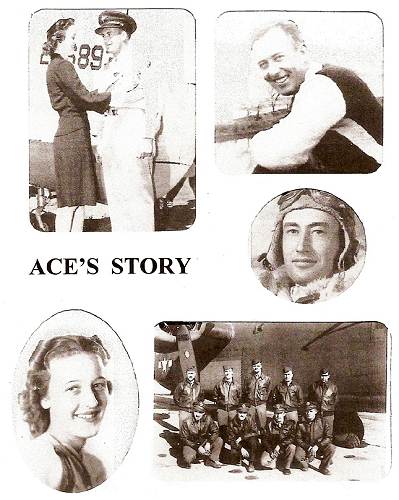
03 Ace's Story INTRODUCTION
This is mainly a story of the military life of Ace W. Tyler. Some background information will be given in order to better understand the person that he was and how his life evolved. Information is based on family records, letters to family, and military records obtained through various sources. An effort has been made to make the sequence of events as accurate as possible, although tight censorship of information after Ace went overseas left some gaps in completely exact dates. This story is an attempt to make available to future readers the details of the life and experiences of Ace. As his youngest brother, the writer of this story is hopeful that those who read it will learn and remember a little more about how Ace lived and died.
Robert W. Tyler, author.
THE EARLY YEARS
Ace Wayne Tyler was born on September 22, 1917 on a farm near Capps in Miller County, Mo. His parents were Barney M. Tyler and Minnie Grace Tyler and at the time of his birth, he had one older sister, Norma Evelyn, who was born in 1914. Younger siblings of Ace and years of birth were Otis Floyd, who died as an infant in 1920; Homer Clay, 1922; Donald Eugene, 1926; Robert William, 1930; and Alta Mae, 1934.
Many have wondered where the unusual name of “Ace” came from. It was a name taken from “Uncle” Asa Grady, a half-brother of our Great Grandmother, Mary Susan Tyler. Most everyone pronounced our brother’s name as the “ace” in a deck of cards. Our parent’s most often used the pronunciation like “A-C”.
Our family lived on a farm most of the time when the children were growing up. My mother used to say that “Dad” was not happy in one place too long. Another reason was likely that, given the state of the economy, one had to move where the best chance to make a living could occur. Consequently, there were quite a few moves when the children were small. From the time when the first child was born (Norma) until the last one was an adult (Alta), there were about fifteen different moves. These included several places in Miller County, two in Maries County, Boone County and Kansas City, Mo. Our father was a farmer and a carpenter and as his sons got old enough they took on chores on the farm, and the daughters did the usual jobs girls did in those days in addition to some farm chores along with the boys.
In the late 1920’s the family moved from Kansas City to the Lurton Farm (photo 04) which was about seven miles down the Osage River from Tuscumbia, Mo.
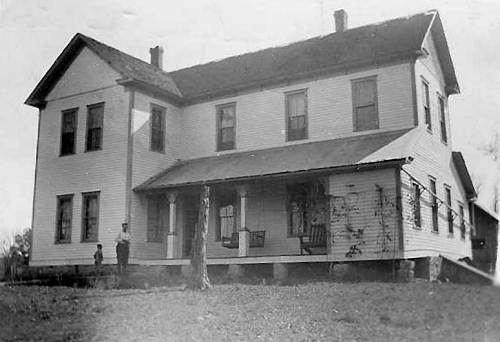
04 Lurton Farm House - Circa 1932 This was a large, river bottom farm and kept everyone very busy to try to scrape out a living during this poor period. Ace and Homer (Don and Bob in later years) attended the one-room school of Lurton which was about a two-mile walk from the home. Ace and Homer then attended the high school in Tuscumbia.
In 1932, our father decided to enter politics and ran for the Sheriff’s office in Miller County as a Republican. He lost this election in the Democratic domination of most national, state and local offices. He ran again in 1936 and won the election. Therefore, a move to Tuscumbia, the county seat followed. The year before this move, however, Homer developed polio and was in the hospital in Marshall, Mo. for several months. One leg was permanently crippled and he wore a brace and walked with crutches for the rest of his life. In Tuscumbia, we lived in an apartment above the jail house next to the court house. Ace graduated from high school in 1936, Homer was in high school and Don and I were in elementary school. Ace’s graduation class had a total of eighteen students. After attending college at Iberia Junior College he took the teacher’s exam. And his first teaching job was in the one-room school at Capps. Later in 1940-41 he taught at Skinner school which was near Eldon. Ace attended college in Warrensburg and Rolla School of Mines in summers for teacher training courses. While in high school Ace played on the basketball team and continued to play for a “town team” after high school (photo 05).
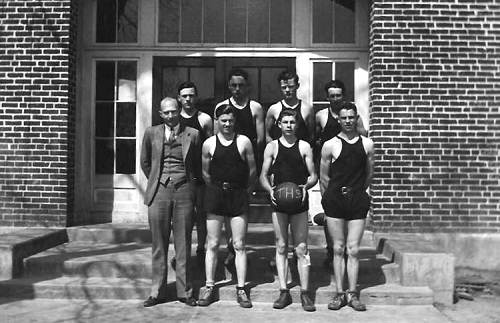
05 Tuscumbia H.S. Basketball Team - Circa 1935-36
FR: Homer Clay Wright - Coach, Gene Templeton, Bill Hall and Alva Vaughn
BR: David Bear, Otis Nixdorf, Joe Wickham and Ace Tyler He evidently was a good player, scoring 8-12 points each game. This was a good part of the team’s total, since during that time very seldom was there a score more than about 30.
Ace and Homer both developed a love for the outdoors and fishing and hunting were always an important part of their lives. Ace got a young bird dog in 1940 and named the dog Wilkie after the Republican presidential candidate of that year. When Wilkie lost to Roosevelt in the election, however, he renamed the dog Lad.
Across the street from our apartment in Tuscumbia lived the Berry’s. Garrett and Clarice Berry had four children who were close in age to the middle four in our family. Mary Jo was the oldest, followed by Wendorf, Conley and Judson. Naturally, the children spent a lot of time together. Ace and Mary Jo began dating around 1940 and would later marry (photo 06).
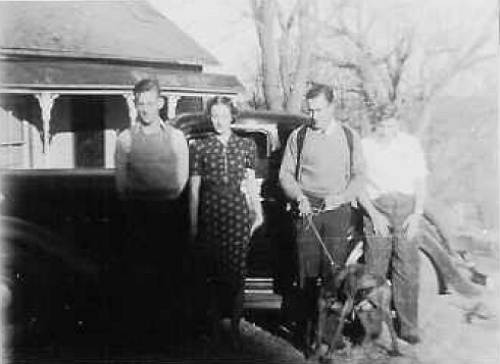
06 Wendorf Berry, Mary Jo Berry, Ace and Homer - 1939 On completion of the four-year term of office, our family moved to Iberia, Mo. In Dec., 1940. We lived in what was known as the Adam’s house which was, ironically, next to the place where my Doubikin grandparents lived when my parents married in 1911. In late 1941, Ace took a job in Boonville, Mo. with the Missouri Training School for Boys, Norma was working in St. Louis, and Homer would start to school at the University of Mo. the following Fall (1942). Don, Bob and Alta were in the Iberia schools. Of course, the memory remains of the event of Dec.7, 1941, the attack on Pearl Harbor and the beginning of World War II for the U.S. Our father went to work as a carpenter to help build barracks buildings at Ft. Leonard Wood and we had at least two boarders who lived with us and worked at the “Fort”. During the summer of 1941, Ace had worked in Kansas in the harvest and had been classified 1-B by the local Selective Service Board.
Even at this time, his goal was to get into the Air Force. One of his physical examinations showed evidence of sugar in the blood and this was a factor that delayed his plans. A later examination cleared him however, and he entered the service on June 5, 1942.
MILITARY TRAINING
Ace was sent to the reception center at Jefferson Barracks, Mo. He had applied for Aviation Cadet Training in April, 1942, before entering service, and was accepted for this training officially in August, 1942. He was told on June 6 that he had qualified for Flying Officer’s Training School and Radio School, which was his second choice. His basic training occurred at Jefferson Barracks and then he was assigned to Air Cadet Training in San Antonio, Texas. In the late summer of 1942, the family moved to Boonville, Mo., where Dad worked in the carpenter shop of the Mo. Training School for Boys. We lived about 2-3 miles outside of town on the poultry farm of the Training School. Mom took care of the chickens (thousands of them), egg gathering, etc. with a little help from Don, Bob, and Alta, but mostly help from a couple boys from the Training School.
PRE-FLIGHT TRAINING
Pre-flight school in San Antonio, Texas began Oct. 11, 1942. It was scheduled to continue for 7 - 9 weeks. In a letter to his brother, Homer in November, 1942, he told about his being named a “Flight Lieutenant” and was given a private room and more responsibility. At this time he mentioned that he wished he had taken more mathematics in school and said,
“…dropped my pencil the other day (in class) and before I could pick it up I’d lost out on a half-year of college physics.”
In this same letter, he said,
“The boys have begun to drop out one by one and the rough stretch is yet to come. I’m keeping my fingers crossed.”
During this period Ace indicated that he and Mary Jo were going to get married and he hoped that he would be able to get leave over Christmas (1942) when they may be married. The leave did not occur and the marriage plans were delayed.
PRIMARY TRAINING
With a transfer to Chickasha, Oklahoma on Dec. 13, 1942, the actual flying part of training began. Primarily they were flying in Fairchild Primary Trainers (P.T. 19A’s). Ace had written to Homer describing it as having “an inverted 6-cylinder Ranger engine with cruising speed of around 100-115 mph. (They’re red-lined at 220 per.)” (photo 07)
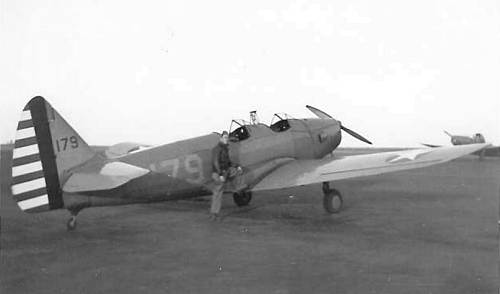
07 Ace with P.T. 19A flown in Primary Training It seemed that Ace enjoyed the thrill of flying as evidenced by what he wrote to Homer on Jan. 2, 1943:
“If you really want to get a thrill try going up around 4000 ft. and push the nose up to the blue until the ship begins to shake like a man with a chill, and dropping off on one wing into a spin and go down turning round and round then kicking the opposite rudder, slamming the stick forward and easing it back. After the first spin everything is just as clear as crystal and you don’t try to hide in the cockpit. We flew upside down awhile the other day and that’s quite a feeling too. These ships are really sweet crates. They’re washing them out pretty fast and one can’t tell when he’s getting a check ride, but it’s certainly no disgrace to washout at this stage. One guy got the skids that had over 1000 hours of flying time with a transport company.”
An important event in a pilot’s life occurred for Ace on Jan. 5, 1943. He wrote to Homer,
“I know you’ll be surprised - but I SOLOED today! Ha! We were practicing landings and the instructor climbs out and slaps me on the shoulder and says, ‘Now take her up and show a few good landings and we’ll go home.’ Man, alive! I swallowed a couple of times - gave her the gun and got in 18 minutes of solo time! It’s a great sensation and that ship responds like a baby. I’ll tell you sometime just how I felt. Ha. Am really proud of those solo wings. Let’s hope I can stay on the ball team, eh!”
A letter of Jan. 9 was further indication of Ace’s love of flying and his continuing good humor:
“All the farmers around here stay inside and their cows have quit giving milk since we’ve begun to solo. Ha! It’s really a rat race up there now. A couple of fellows were flying solo over on an auxiliary field yesterday and upon landing one fellow got too close to the other and his prop chewed the first plane’s tail assembly all to pieces. Ha. We let down right after it happened and the instructor crawled out, looked at me and said, Nervous?’ I wasn’t so he told me to take her on up. Am improving in my landings and don’t bounce 20 or 30 ft. every time I hit the ground. Ha. We were up around a mile high today doing stalls and spins. You can see for miles and miles and looks as if there’s a patchwork quilt spread out beneath you. Am getting so I can do a fairly decent spin now. It’s a little scary starting the spin, but while you’re spinning everything is just as clear as crystal. We’ve done stalls, spins, S’s, elementary eights, rectangular courses, climbing turns, gliding turns, Schandells, landings, take-offs, and a few more simple maneuvers. Ha. I’ve done all of them by myself but they’re pretty rugged yet. Ha.”
A letter to Homer on Jan. 30 further indicates the joy of flying, but also the difficulty of training and anxiety about being able to complete this phase. He wrote:
“Well, Homer, your ol’ bud has only about 12 or 13 hrs. to go (flying time) here. They’ve been washing out an awfully lot lately. I guess we have around 85 left out of our original 200+. Two of my buddies washed out - one today and the other a couple days ago (VanFleet and “Goldie” Thompson). I’m due for my check any time now and I dread it. Have been doing everything in the book. We’re allowed 2 ½ hrs of flying time each day. Of course we’re only on the line ½ day. The hardest maneuver for me is a half-roll or maybe the Immelman. It’s a little difficult for me to manipulate the controls when I’m wrong-side up. Ha. Usually get around two hrs. solo each day and believe you me if it’s at all rough one gets plenty worn out. Hope I can stay on the ball team. Am getting so I don’t give a d… though.” . . . “A fellow got lost yesterday and they found him about 18 miles or so out of the area down in a stubble field without a scratch. Our practice area is about 15 by 20 miles. Lots of room to play around but the planes are as thick as flies.”
Mary Jo came to visit Ace on the weekend of Feb. 13-14 and he left Chickasha for Enid, Oklahoma for Basic Training on Feb. 16. He indicated that they would be flying B.T 14’s, with a 450 H.P. engine. They were supposed to get quite a lot of formation and night flying. He told Homer:
“Say, kid, I’d give anything to get you “upstairs” in one of these P.T.’s, ha. Two-bits to a nickel I could make you ’toss your cookies’, ha.”
BASIC TRAINING
There were quite a few cross-country trips of about 200 miles and night flying included in Basic Training. This was also where Ace had his first exposure to tight formation flying. Evidently security became more strict as Ace sent his camera to Homer and said that he was not allowed to use it.
Several times, Ace indicated how hard they were working and how tiring it was for him. He also appeared frustrated at times about the supposedly strict discipline rules they had to adhere to, even though he realized that there were a lot of very young guys in the program and it probably was needed.
According to his flight records, Ace logged 73 hours of solo and another 67 hours of dual flying while at Enid. Near the end of Basic Training, Ace was hoping for a pass so he could go to Kansas City to see Mary Jo. He did get a short pass in mid- April and spent the weekend in K.C. He said there was not enough time to get married then, but they were planning it at the time of his graduation from Advanced Training. He was transferred to Pampa, Texas on April 19, 1943 for Advanced Training and would receive a commission upon graduation.
ADVANCED TRAINING
Most of the training at this station would be in A.T. 17’s which were twin engine planes (photo 08).
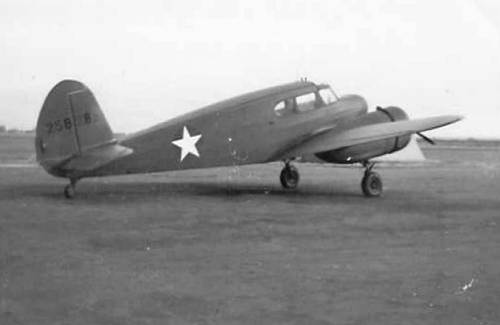
08 A.T. 17 Flown in Advanced Training It was indicated that they always flew with at least two people in this plane, although it had a capacity for five. There were increased distances for cross-country flights (400-500 miles).
“Don’t know how I’m ever going to be able to fly for a whole day when 4-5 hours now just about peters me out. It really gets tiresome after the first couple of hours. The darn plane just flies like driving a car. We flew about 300 miles at 500 feet off the ground.”
During this stage of training, Ace also flew A.T. 9’s at times. He said the A.T. 17 was easier to land because it wasn’t as fast as the A.T. 9. He told about taking part in an air search for a lost plane from Lubbock Field. They were to fly slow (@120 mph) and about 500 ft. above the ground. He never mentioned whether or not the plane was found. Ace flew more and more formation and instrument flying. He spoke of this:
“Flew about an hour and a half under the hood yesterday. Man, I sure do hate that. A black cover is snapped over your seat in the cabin and you fly by instruments alone. I had a sad time following the beam in as I was a while locating myself. Ha. It’s possible to take-off, fly, and land these planes on instruments alone, but believe you me it’s certainly no child’s play.”
It was first in this letter of May 21 that he indicated what was expected for his assignment after graduation. He thought there was a possibility of getting a B-24, B-26, Air Transport Command, Air Service Command, or Instructor.
“The Ferry Command would really be a good deal, but chances of getting that are pretty slim.”
I discovered in February, 2009 that Ace was involved in a training accident during this period. On May 30, 1943, he had an accident which is outlined below in part of the accident report (photo 09).
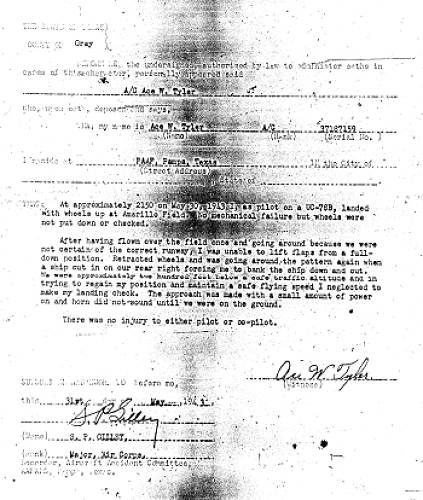
09 Accident Report - 1943
Click image for larger viewHe never wrote anything about the accident and we were not aware of it. Fortunately, no one was injured and evidently, it was not enough to “wash him out”.
In a letter of June 11, Ace said,
“They’re flying us to a frazzle every pretty night and I sure wish this night time was all in. I still have better than eight hours of night cross-country time to get in.. . .I think Jo is coming down next week - I hope. Don’t know if I’ll get a leave or not yet. Would sure like to have a couple weeks.”
Ace finished Advanced Training and received his Silver Wings and was commissioned a 2nd Lt on June 24, 1943, and was married on this day to Mary Jo Berry (photo 10).
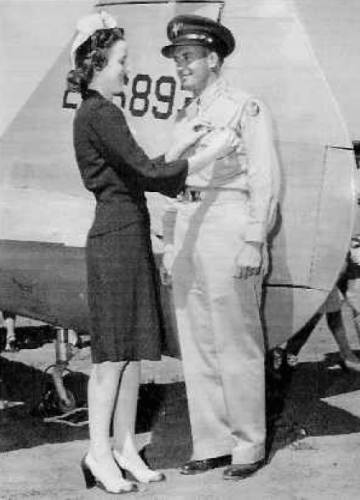
10 Pinning on his Wings - 1943 A brief leave followed in which they visited the Berrys in Independence, Mo. And the Tylers in Boonville, Mo (photo 11).
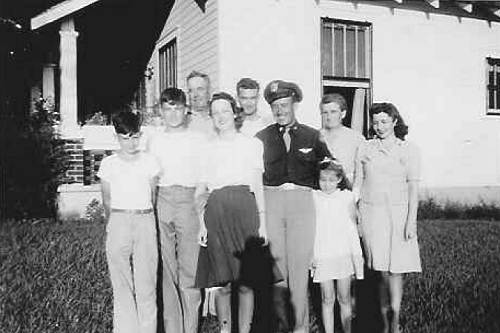
11 Tyler Family in Booneville, MO - June 28, 1943
(Last picture with family together) Ace was transferred to Liberal, Kansas on June 26, 1943 where he had his first contact with the B-24. He and Jo had a difficult time finding a place to live in Liberal, but finally found a two-bedroom place with a kitchenette. They shared this place with another pilot and his wife (Lt. and Mrs. Carl Yandt).
INTRODUCTION TO B-24
“The plane, lad, is really OK. The first time I looked at the instrument panel (photo 12), I almost fell backwards. Ha. Ye gods, and little fishes! You never saw so many instruments in your life. It just uses about 200 gallons of gas an hour (more than an “A” card for a year). All these planes are brand new, as is everything else around here.”
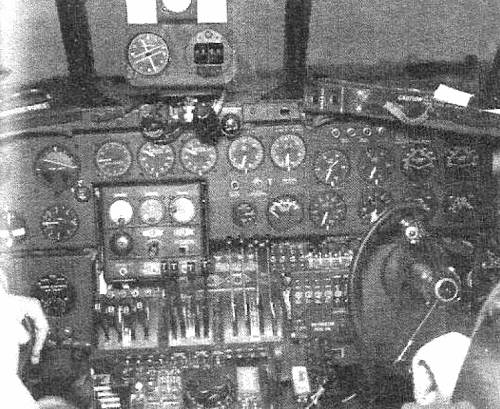
12 B-24 Cockpit Instrument Panel The B-24 was built in greater quantity than any other plane in World War II (more than 19,000). There were several different versions designated by different letters, changing with each modification made of the original. The name of “Liberator” was given the B-24 by the British early in its history. It was called by many other names, often in a derogatory way. Probably the most common was the “Flying Box Car”. Supposedly given the name by those partial to the B-17, saying that it looked like the “box” that the B-17 was shipped in. The Liberator had a wingspan of 110 feet, a fuselage sixty-seven feet long and eighteen feet high. Empty, the plane weighed 32,500 pounds. Its maximum weight with bomb load was about 60,000 pounds. The B-24H (most common version flown at this time) carried ten .50 caliber machine guns, two in the nose, two in the top turret, two in the ball turret, and two in the tail, all power-operated, and one manually controlled .50 caliber on each side of the waist. The plane had a maximum speed of almost 300 miles per hour, could fly as high as 28000 feet, and had a range of 3700 miles (without bombs), and 2100 miles with 5,000 lbs. bomb load, all exceeding the capability of the B-17.
It was almost universally agreed that the B-24 was the hardest plane to fly. George McGovern was quoted in Steven Ambrose’s book “The Wild Blue” as saying,
“I don’t think there’s a person alive that could fly a formation of B-24s for ten, twelve, thirteen hours that wasn’t trained the way we were. I don’t think he could do it.”
It sounded as if McGovern was impressed with the cockpit of the B-24 the way Ace was, saying that when he first climbed onto the flight deck and sat at the pilot’s seat, he was confronted by a bewildering sight. There were twenty-seven gauges on the panel, twelve levers for the throttle, turbocharger, and fuel mixture, four on the pilot’s side on his right, four on the co-pilot’s side on his left. The wheel, or “yoke” as it was called, was as big as that on a large truck. There were over a dozen switches, plus brake pedals, rudders, and more.
Note: I had an interesting conversation with a pilot of a B-17 in Feb. 2004 at the 8th Air Force Museum in Savannah, Ga. about comparing the B-17 and B-24 in regard to difficulty in flying. He told me that he had been trained totally on the B-24 and when assigned to his final station in England, he was told he would be flying a B-17. After four takeoffs and landings, he said they told him he was ready for combat. This indicates that if one could fly the B-24, they could fly just about anything. This pilot was shot down twice.
Jo would often write Homer, and include the letter with one from Ace. In a couple letters, she referred to Ace as “Cake-eater”. I’m not sure where this “nick-name” came from, but it sounds like one could figure it out. On their one-month anniversary, she said,
“Can you beat this? We were married just one month ago today and “my old man” says it doesn’t seem a bit over a year. Grounds for divorce, don’t you think?”
Ace said that he planned to fly over the folk’s house in Boonville on one of his cross-country trips. He wrote and told us when he would fly over and we anxiously awaited that day. Everyone rushed outside, waving and yelling. Of course, Don and I had been out there most of the day, waiting. It was an exciting time for us.
During his time at Liberal, Ace flew the B-24E, logging 56 hours in July and 75 hours in August and September (until the 9th) (photo 13).
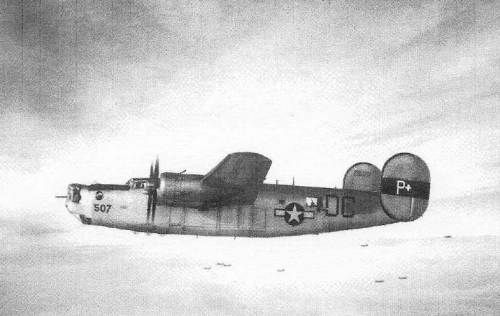
13 B-24 of 392nd Bomb Group, 577th Squadron There was a lot of cross-country and night flying included. In one 24 hour period he spent 10 hours in the air. He indicated that each time he took the ship up he liked it better.
CLOVIS, NEW MEXICO
Ace was transferred to Clovis on Sept. 9, and Jo went back to Independence, since there was no place for them to live in Clovis. Information is sparse about the kind of training that occurred at this station. His flight records indicate that he flew in the B-24-D most of the time and logged 35 hours in about 15 days of flying while at Clovis. On Oct. 16, 1943 he was transferred to Blythe, California. Before reporting to Blythe, he was given a short leave so he went to Kansas City for a few days. He left there for Blythe on Oct. 22.
BLYTHE, CALIFORNIA
On reporting to this base, Ace found that his cousin, Raymond Gardner, was stationed there, so they had some good visits together. His air crew was organized at the beginning of the time at this station. He said,
“Have a swell crew. Navigator, Bombardier, Co-pilot and I went to the show tonight. A great bunch of guys. Rode with the co-pilot and he’s going to be OK.”
Again, Jo was not able to join him at this base since there was no place to live.
Ace did a lot of flying while at Blythe, mostly long distances, logging 66 hours in 18 days flying for the month of November. On five other days, time was spent on the Link Trainer. So they were quite busy during this time. He wrote on Nov. 24,
“Been flying our tails off lately on 8 hr. missions. I took some Major to El Paso, Texas last Tuesday. Took a Captain to Tucson and back here without stopping. We were up for 7 ½ hours yesterday and 5 ½ hours of that was at 20,000 feet on oxygen. Didn’t feel so bad, though.”
Following is a list of the crew members during the time in Blythe (photo 14):
2nd Lt. Ace W. Tyler Pilot - Boonville, Mo.
2nd Lt. Joseph A. Ricci - Co-pilot - Georgetown, Colo.
2nd Lt. Raymond J. Carley - Navigator - Brooklyn, N.Y.
2nd Lt. Melford R. Butts - Bombardier - S. Hanover, Mass.
S Sgt. George E. McDonald - Engineer - Holyoke, Mass.
S Sgt. William Metz - Radioman - Teaneck, N.J.
Sgt. Gilbert R. Brown - Left Waist Gunner - El Paso, Texas
S Sgt. George Dikun - Right Waist Gunner
Sgt. John M. Blaida - Tail Gunner - Monroe, Mich.
Sgt. Paul D. Podolski - Ball Turret Gunner - Dedham, Mass.
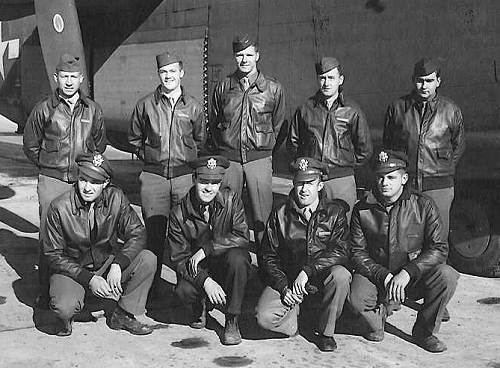
14 Original Crew (probably taken in Blythe, California
FR: Lt. Melford Butts, Lt. RAymond Carley, Lt. Ace Tyler, Lt. Joseph Ricci
BR: unknown, Sgt. Paul Podolski, Sgt. John Blaida, unknown, Sgt. Gilbert Brown On Dec. 20, the crew was transferred to Herrington, Kansas. During January, 1944, records are incomplete, but it appears that Ace and crew left Herrington on Jan. 10th and flew to Morrison Field, West Palm Beach, Florida. Just before leaving Herrington, George Dikun, Right Waist Gunner, was replaced by Sgt. Corbett X. Miller, hometown of Rockwood, Pa. Records do not indicate the reason for this change.
FLIGHT TO ENGLAND
There were different ways the Air Force transported new crews to bases in Europe. Some were taken by ship from Eastern ports to Europe. Others flew planes a Northern route, going over Nova Scotia and Iceland, to Ireland and England. Many of them took a Southern Route which took them from Florida to some Island in the Caribbean, often Puerto Rico, then to Brazil, to Africa and then to the British Isles. Evidently this is the route Ace and his crew flew. The plane flown from the U.S. was No. 41-28712. I’m sure a short time was spent at each stop along the way, but the only record available of where they stopped was in Marrakech, in North Africa. They arrived there on Jan. 22. The next stop was in Ireland on Jan. 28 after over a nine-hour flight. They stayed at this station until Feb. 17, then transferred to Station #238, also in Ireland. This was the Combat Crew Replacement Center at Cluntoe, Northern Ireland (due west of Belfast on the western shore of Lough Neagh). This was where the newly-arrived crews reported, went through indoctrination, got last-minute training, and waited to be assigned to a Group. Below is a copy of a “V- Letter” written to me from Ace in Ireland dated Feb. 24, 1944 (photo 15).
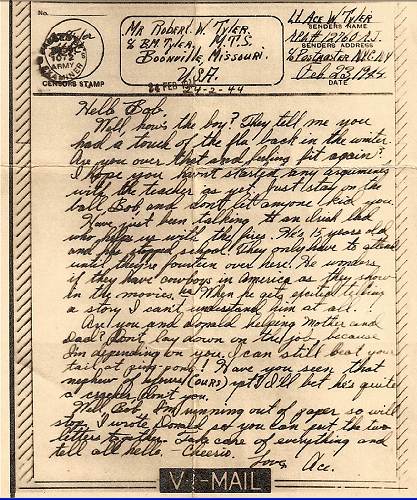
15 Letter from Ace - 1944
Click image for larger view
WENDLING AIR BASE
On March 3 the crew was assigned to the 576th Squadron of the 392nd Bomb Group at Station 118, Wendling, England. This base was actually closer to the village of Beeston, but the train stopped at Wendling, therefore they called it the Wendling Air Base. The following maps and pictures show the Air Base as it appeared in 1944. On the first map, Site #6 was where Ace’s squadron (576th) was housed (photos 16, 17, 18 and 19).
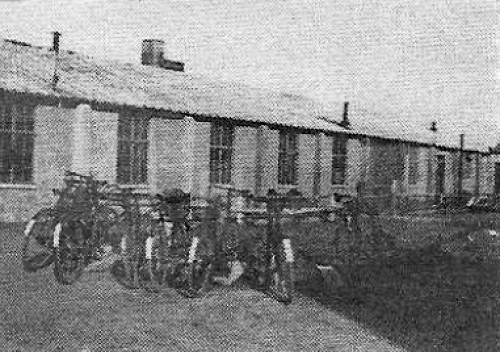
16 Officer's Mess with typical transportation in front
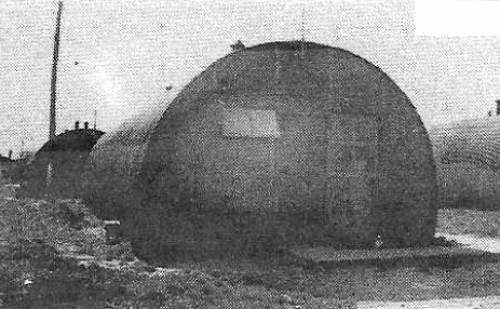
17 Quonset Huts where crews lived
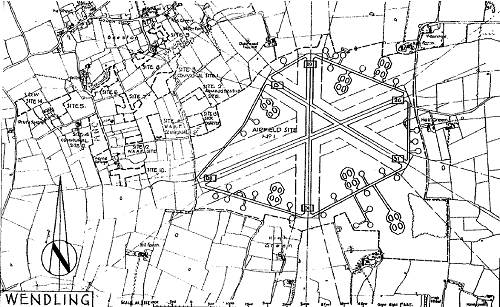
18 Map of Air Field and Surrounding Support sites and Village of Beeston
Click image for larger view
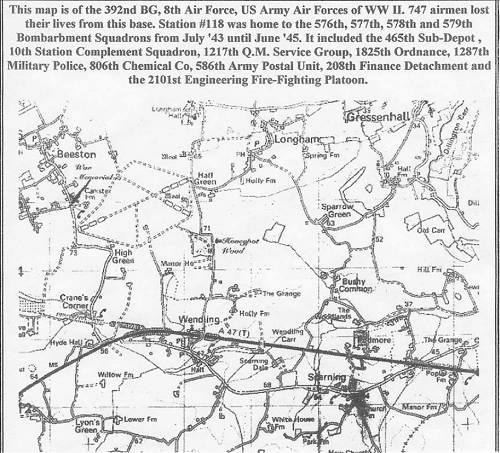
19 Larger Map showing area including Villages of Beeston and Wendling
Click image for larger viewDuring the first week of March some time was spent on the Link Trainer and one flight of three hours was recorded. This was likely a training flight. The Quonset huts where the crews lived were heated by small stoves that burned coal. The normal means of transportation from one part of the base to another was by bicycle.
COMBAT MISSIONS
Before going into the details of combat missions of the 392nd Bomb Group in which Ace participated, and other significant missions, an attempt will be made to give some statistics related to the group and discuss the organization involved in carrying out the missions. The 392nd was only one of about 50 bomber groups flying from English bases in only the Eastern part of England, known as East Anglia. Many missions included several groups combined so that there may be a total of several hundred bombers on one mission. The following map (photo 20) shows how many bomber and fighter groups were part of the 8th Air Force and located in East Anglia. There were many others in other parts of England.
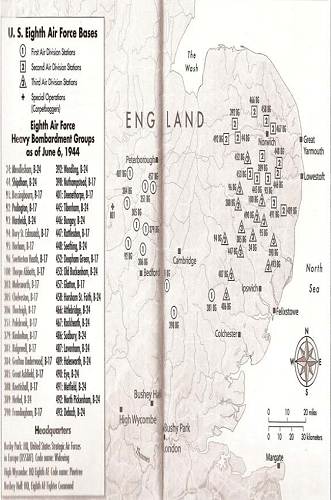
20 U.S. Eighth Air Force Bases
Click image for larger viewThe extremely crowded skies, combined with bad weather and poor visibility much of the time, made it very difficult. Many mid-air collisions resulted even before planes left the skies over England. After forming of the groups had been accomplished, planes were expected to fly in very tight formation-almost wing-tip to wing-tip. Another factor which contributed to formation problems was that the B-24 controls seemed to become even more sluggish than normal at altitudes above 20,000 feet. It took brute strength and extremely sharp reflexes to fly this plane. Pilots were expected to hold to this close formation, even when under attack from enemy planes, or through flak barrages, until bombs had been dropped. Even after this, their protection was best if they maintained tight formation for the trip home. So damaged planes often would not be able to stay up with the group and therefore, became prime targets for enemy fighter planes. Friendly fighter escorts were valuable, particularly for damaged planes. Early in the air war, Allied fighters did not have the range to accompany the bombers to many of the targets in Germany. Early in 1944, however, with the introduction of the P-51, escorts became more common on the longer missions.
Other factors that contributed to the difficulty of the missions included cramped space in the planes and temperatures at high altitudes. It was obvious the B-24 was not built for comfort and it was even difficult to get into the plane and out of it. The bombardier, navigator, and nose gunner squeezed through the nose wheel well of the ship, then found their place in the extremely small area in the nose of the plane. The nose gunner could not normally wear his parachute when in his combat station. The rest of the crew entered the plane through the open bomb-bay doors, walked along a narrow catwalk, then to either the cockpit or the waist and tail of the ship. Leaving the plane in an emergency was also difficult and many times they would have only a few seconds to get out if the plane had been hit (if they could squeeze through the small openings). The crew had to wear heavy clothing and electrically heated flight suits (which sometimes would not work properly or would short out when the electrical system was damaged). The temperature at high altitudes would be 30-40 degrees below zero, so the heavy, heated clothing was a necessity. The area of the waist guns on each side was completely open to the outside, allowing the wind and cold to blow through the plane. One can imagine the difficulty of moving around in the small spaces with all the clothing and equipment. Crew members also had to wear oxygen masks, since the planes were not pressurized. They would keep these on for hours at a time. The following picture shows the positions of the crew in the B-24 (photo 21).
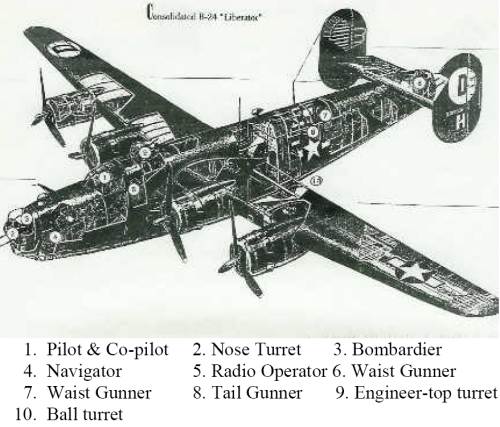
21 B-24 Cutaway
Click image for larger viewWhen one looks at the losses of planes and personnel, the numbers are staggering. For the years of air combat in Europe, the U. S. lost almost 10,000 bombers of all types, plus another 8,000 that were damaged beyond repair. In 1944 alone, flak destroyed 3,501 American bombers, and German fighters destroyed about 2,900 more. The Eighth Air Force lost 26,000 airmen killed between 1942 and 1945. The 392nd Bomb Group, which was the fourth oldest in the Eighth Air Force, lost 184 aircraft and had 1,553 airmen casualties. Only the 44th Bomb Group lost more planes (192) than the 392nd. This may be partially explained by the fact that the 392nd was a leader in bombing accuracy. During the period of Feb.-May, 1944, it bombed with greater accuracy than any other European Theatre Liberator Group. They were dedicated and determined to achieve their goal of hitting the target.
Some other sobering statistics are that until mid-1944 the life expectancy of a bomber and crew was 15 missions, with a crew member having only 1 chance in 3 of surviving a tour (30 missions at this time). About 50% never made it through 5 missions.
Targets of the 8th Air Force included U-boat installations, shipbuilding, aircraft factories, railway centers, missile launch sites, oil refineries, other war industrial plants, and others. The following map shows some of the sites bombed and the limit of the escort fighters for the missions (photo 22).
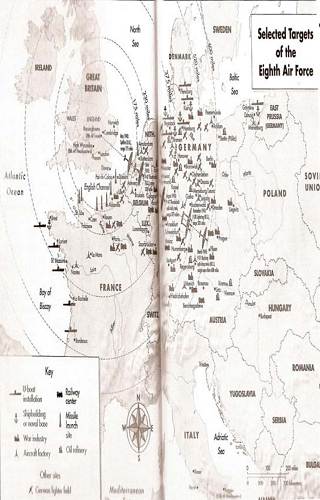
22 Targets of the Eighth Air Force
Click image for larger viewIn the following summaries of the missions, the ones for which Ace was given combat credit (counted as a sortie) are given numbers. Other missions may be discussed, since they were significant in the history of the group or to Ace’s experience.
Mar. 8, 1944: Mission #1
Target: Erkner, Germany
Erkner was about sixteen miles southeast of Berlin. The specific target was the ball bearings works. If the weather obscured the primary target of Erkner, the planes were to bomb the secondary target, which was the railway station in Berlin (Zoo-Garten Bahnhof). This was the first actual mission to Berlin, so they expected heavy resistance.
On a previous mission to hit Berlin, on Jan. 24, planes had been recalled due to weather.
Twenty-four planes of the 392nd participated in this Erkner mission. This was only a small part of the total force of bombers to this target that day. There were a total of 468 planes with three combat wings making up the lead force, four combat wings in the second force, and three combat wings of the 2nd Division making up the third force. The 392nd was in this third force. Escorts included seven P-47 groups, four P-51 groups and one P-38 group. The two leading wings were subjected to mass fighter attacks from Dummer Lake to the target area. Two P-47 groups heavily engaged the enemy fighters, and although greatly outnumbered, decisively outfought the enemy, claiming 30 destroyed while losing 5. A total of 63 destroyed, 17 probably destroyed, and 19 damaged were claimed by all fighter forces. For the total U. S. losses, it was 36 bombers lost and 40 received major damage while 17 fighters were missing while 9 sustained severe damage.
Ace was assigned as co-pilot in the Ellison crew. This was a normal procedure for a new pilot, and it was the 10th mission for the Ellison crew. The 392nd reports indicated that flak was encountered and some 25 single and twin-engine enemy planes were sighted. One of these was shot down. The bomb run was successful, with 1,184 - 100 pound bombs dropped. The Ellison crew flew in plane #560 and was positioned over the target in the right rear of the formation. Ace would fly this same plane in a later mission (Apr. 12 to Zwickau). (This plane crash landed at Wendling on 10/29/44 after 34 missions). Fighter support of P-51’s was reported as excellent. Fourteen aircraft of the twenty-four from the 392nd sustained some damage, but all returned safely with no losses or aircrew member casualties. They were fortunate to have been in the third force on this mission, since the greatest losses occurred in the lead force. The records indicated that a “highly jubilant group returned from this mission, our first real one to Berlin.” Ace’s flight records indicated that he flew 4:25 hours as co-pilot and 4:00 hours as first pilot. For the first combat mission, this must have been a memorable one. Below is a picture of planes dropping bombs on this mission (photo 23). One cannot identify aircraft numbers, but one of these may have been the Ellison crew’s plane.
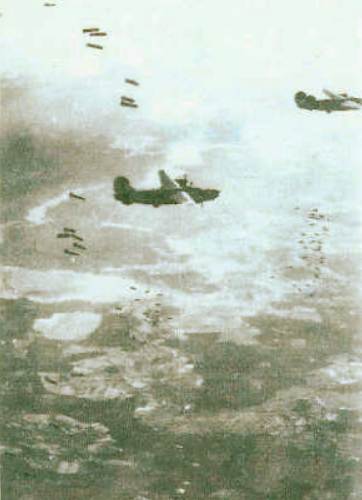
23 Liberators dropping bombs over the Erkner Ball Bearing Factory near Berlin - March 8, 1944 Mar. 16, 1944: Mission #2
Target: Fredrichshafen
This was the first mission to this target of the Dornier Aircraft Assembly Plant on the north shore of Lake Constance in southern Germany. This was the first time Ace flew as the pilot. The following were crew members of this first mission as pilot:
Ace. W. Tyler, Pilot - W. Metz, Radioman
J. A. Ricci, Co-pilot - C. X. Miller, Right waist gunner
R. Mitchell, Navigator - G. R. Brown, Left waist gunner
H. E. Stetson, Bombardier - P. D. Podolski, Ball Turret gunner
G. E. McDonald, Engineer - J. M. Blaida, Tail gunner
Note that Ray Carley, Navigator, and Mel Butts, Bombardier of the original crew were not included. They both had volunteered to fly on an earlier mission on Mar. 6 to Genshagen with another crew and their plane was shot down, they parachuted out and were taken prisoner. Ace had lost his Navigator and Bombardier before even flying a mission with them. So on their first mission, they became POW’s and replacements (Mitchell and Stetson) joined the crew for this mission to Fredrichshafen. This information about Carley and Butts was obtained in Dec., 2003 through a telephone conversation with the widow of Mel Butts. He had died in the mid-1990’s. No information has been forthcoming about where Ray Carley is, or whether he is alive.
Briefing for this mission took place between 0345 and 0600 hours and at 0725 the first of 29 planes from the 392nd took off. Ace was flying in aircraft #670. On nearing the target, it was reported that there was 10/10ths cloud cover (totally obscuring the target). Mission reports indicated that the results of bombing were unobserved due to the cloud cover. No enemy aircraft were encountered and flak damage was minimal. Ace’s plane was reported to have the top-turret right gun inoperative, and a nose-turret left gun charging handle malfunction. The position of the plane in the formation was the right side of the left wing at the rear of the formation. This was called “tail-end Charlie,” and was a very vulnerable position in the formation to attack from enemy fighters.
All planes returned to base without casualties. This was a very “easy” mission compared to the next one to Fredrichshafen two days later. In the flight records, it was indicated that Ace flew 8:50 as first pilot.
In order the show the magnitude of the bombing effort at this time, records show that on this day there were three different forces involved.. The 392nd was part of the third force which was directed to the target of Fredrichshafen. Other targets were factories and airdromes at or near Munich and Augsburg. There were a total of 793 bombers airborne this day but due to some assembly problems only 742 actually were dispatched, 222 B-17s in the first force, 281 B-17s in the second force, and 239 B-24s in the third. In regard to fighter support, 19 U.S.A.A.F. fighter groups of the Eighth and Ninth Air Forces and eleven Spitfire Squadrons of the R.A.F. participated in this operation and three P-47 groups flew double sorties. Of the 968 American fighters airborne, 868 were credited with sorties, 287 P-47s and 79 P-38s on the penetration, 135 P-51s and 46 P-38s through the target areas and 321 P-47s on the withdrawal. R.A.F. withdrawal support totaled 130 Spitfires. Total losses for this day included 23 bombers (18 B-17s and 5 B-24s). Battle damage was sustained by 156 aircraft, including 39 cases of major damage. Claims by the bombers against enemy aircraft amounted to 68 destroyed, 32 probably destroyed, and 43 damaged. Most of the losses, damage, and claims were by the first force whose target was mainly Augsburg. From the supporting fighter force, 12 aircraft were lost, while their claims included 78 destroyed, 7 probably destroyed, and 33 damaged, including 1 destroyed and 13 damaged on the ground.
The above description illustrates the magnitude of the air war being waged at this time. Through most of this narrative, I have and will focus on the operations of the 392nd only. This usually involved twenty-some bombers with each mission.
The next day (Mar., 17) Ace was scheduled to fly a mission in aircraft #371, but the mission was scrubbed due to weather.
On Mar. 18, the 392nd suffered the heaviest losses in both aircraft and crew of any other mission of the war. Ace was in on the briefing for this mission but was scratched at the last minute. This mission was also to Fredrichshafen, but the enemy was waiting for them this time. Of 28 planes in the group, fifteen aircraft and crews would be lost and nine other ships damaged by fighters and flak. A total of 154 casualties resulted from this mission. Four planes aborted due to mechanical or other problems prior to reaching the target and two planes collided over France, with both planes going down. Due to difficulty in coordination in timing with fighter escorts, the remaining planes were attacked by 60-75 German fighters. During the air battle and flak attacks that lasted about 35 minutes, 12 more planes were lost. Seven planes returned to England, all with extensive bomb damage. Lt. Bassett, who later would be the Navigator on most of Ace’s missions, flew with Lt. Ellison, but their aircraft aborted following the mid-air collision over France. After this mission, the group only had 13 planes, and many of them were badly damaged.
Still, three days later, 13 Liberators from the group participated in a mission to Watten.
Mar. 26, 1944: Mission #3
Target: Febvin Palfart (No-Ball)
The label of a target as “No-Ball” indicated that it was likely to a rocket launching site and was a rather short mission, usually near the coast of France and less resistance was usually expected. Sometimes, however, unexpected heavy enemy flak or aircraft was encountered. There were no “easy” missions.
The group was originally assigned the target of Oscherslehen, but at the last minute the target was changed. At 1215 hours, 24 aircraft began take-offs. The target area was visible and bombing results were excellent. One aircraft and crew was lost to AA fire. No enemy aircraft were seen but AA was intense and accurate. Seven other aircraft had battle damage. Ace flew in aircraft #131 in right “tail-end Charlie” of the high block. Hurdle, who was regularly in Ellison’s crew flew as the Bombardier. The total flying time was 4:35.
It would be almost three weeks before Ace and crew would fly another mission. His flight record indicated that some time was spent in practice flights and time on the Link Trainer. In a letter to Homer of April 5, he indicated that he had been on leave to London and that he and Wendorf Berry, who was stationed in England, were planning to get together. He also asked Homer how the name “Queen Mary” would sound for their plane. Obviously, this would be named after Jo. No naming of the plane occurred, however, as far as could be determined.
Normally, a crew was assigned to one particular plane and flew that plane only, unless it had mechanical problems or had been damaged so that it could not be flown until repaired. This is why they often picked names which had some specific meaning for that crew. Ace and crew seemed to have been given a specific plane as indicated above and in another letter where he had written that he and crew had spent an off-day cleaning up the “ship“. The statistics gathered in studying the missions however indicate that Ace flew eleven different planes in 17 missions. The most any one plane was flown was 4 times. This was plane No. 136 (A-Able), and was the plane flown on the last mission. Possibly battle damage was sufficient to prevent the assigned plane from being flown each mission.
A mission, which turned out to have embarrassing consequences and international complications, occurred on April 1. Ace was not included in this mission. The target was supposed to be Ludwigshafen’s chemical works. Twenty-three planes took off at 0645. In route to the target, the lead ship, with the lead navigator in charge, somehow made an error in navigation with heavy cloud cover and the Group’s aircraft were led some 120 miles southeast of the briefed target. When they dropped their bombs they were approximately 10 miles into neutral Switzerland. Upon returning to base they learned that the bombs had landed near the Swiss city of Schaffhausen. A total of (1184) 100lb. bombs had been released in the area. No casualties occurred with the 392nd, but some planes suffered anti-aircraft fire damage on the return trip. Needless to say, on returning there was a lot of explaining to do-especially for the lead ship.
A story was told to me by Judson Berry in 2003 which concerned this particular mission. He said that in the mid 1950’s he was in Germany for an extended period in work-related duties and he and his wife Mary Lou had during the summer of 1954 gone on a little trip and had been in Schaffhausen, Switzerland for lunch. Of course, they knew nothing of the mission which had occurred on April 1, 1944. The waiter in the restaurant asked if they were English and they told him that they were Americans. The waiter said they should not tell anyone because about ten years before their city had been bombed by the Americans. Some sources have said that this bombing may not have been the accident it was purported to be, since there was the possibility of factories located there which may have been supporting the German war effort.
Heavy casualties occurred for the 392nd on missions of April 8, 9, & 11 to Brunswick, Tutow, and Bernberg. A total of seven planes and crews were lost with another plane lost when it crash landed in England with all crew surviving. Two planes were lost due to a mid-air collision and in another tragic accident, a plane was hit by the bombs from a plane above.
April 22, 1944: Mission #4
Target: Hamm
This was one of the first missions flown late in the day with 27 aircrews taking off at 1530. This meant that return would be after nightfall. During the bombing run on the marshalling yards at Hamm, the leading ship was hit by AA fire. This caused the deputy lead ship to take over, however it was then too late to bomb the assigned target. The first section of Group ships continued around to bomb a Target of Opportunity believed to be the airfield at Chievres, Belgium, southwest of Brussels. The second section made a 360 degree turn and dropped on the Primary target of Hamm with good results. Shortly after, this group was attacked by about 60 single and twin engine enemy fighters. AA fire was also severe and accurate between fighter attacks. The group suffered 26 casualties and lost two aircraft. A total of 17 planes received battle damage. Ace flew in aircraft number 415 in the first section. Seven to nine enemy ME 109s attacked the plane and Podolski was credited with destroying one. Podolski was listed as the nose-gunner on this mission.
Corbett Miller, listed as the tail-gunner on this mission, was wounded. In talking with a nephew of Corbett Miller in October, 2003 in Somerset, Pennsylvania, I was told that Corbett could not get up from his tail-gunner position on the return flight because his blood had frozen his body to the seat. This would be the last combat mission for Miller, as his wounds to his back and hip were severe. I was told that he never fully recovered from the wounds after the war. At the end of this journal there will be additional information about Corbett Miller.
This was the first mission which Lt. Bassett was assigned as Navigator. The aircraft landed after dark and it was on this date that enemy aircraft followed the returning bombers home to England and hit various Group bases with low-level attacks. The 392nd, however, was not one of the groups attacked, either in the air or on the ground. The records of the 2nd Division indicate that 10 aircraft were damaged before landing, 2 were damaged on the ground and 8 aircraft crashed or crash landed, all attributed to the enemy intruders. Personnel casualties attributable to the enemy intruder action were: In air: 7 killed, 17 wounded, and 1 missing (parachuted over water, lost); On ground: 1 killed and 5 injured; and by Crash or Crash Landings: 29 killed and 1 injured. This turned out to be a devastating end to the mission for several of the groups. There seemed to be only 10-15 enemy aircraft that took part in these attacks. Part of the problem appeared to be that since they were returning after dark, visual recognition was difficult and they did not know they were enemy fighters until they were very close. Also, there was a lot of preparation for landing, including much radio activity, so that warnings were often not heard. One wonders why this tactic had not been used more often by the German fighter groups.
The individual flight record for Ace show that this mission occurred on April 21. I assume this was a misprint, since the official mission reports show April 22. The total time flown on this mission was 4 hours and 10 min. with one hour being on instruments.
On April 24, the target was Leipheim. At 0900, twenty-six aircraft began take-off. Ace flew in aircraft #617 and they experienced a left landing gear problem (would not stay retracted). Due to this problem he had to abort the mission and landed on another airfield near London. Anderson flew as the Navigator and Wimberly was the replacement for Miller. The bombing group lost two planes on this mission and suffered damage to four others. No sortie credit was given to Ace’s crew since they had to abort the mission.
According to Individual Flight Records, Ace flew a combat mission on this date, however mission reports indicate no mission other than the one to Leipheim. The Flight Records indicated first pilot times as 1:25 for the non-combat mission and 3:15 for the combat mission. In numbering the combat missions, I have listed this as Mission #5. After completion of five combat missions, Ace was awarded the Air Medal.
Copies of the official forms used for aborted missions are shown on following pages (photos 24 and 25).
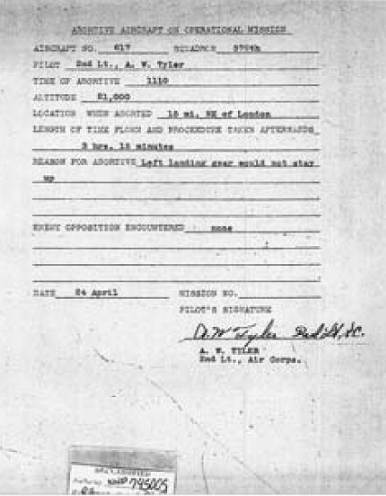
24 Abort Mission Papers
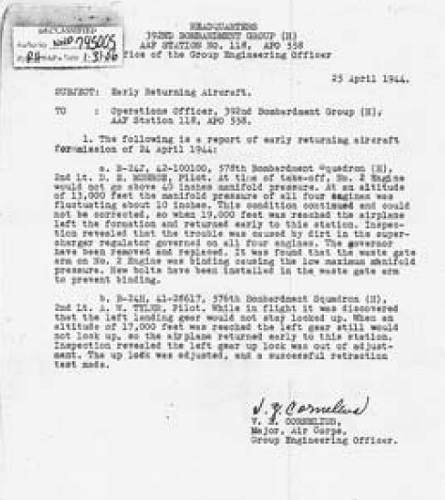
25 Abort Mission Papers April 25, 1944: Mission #6
Target: Wizernes (NoBall)
The launch of 23 aircraft occurred at 1140. Bombing effectiveness was unobserved due to a heavy undercast (since clouds were under planes, instead of overcast, it was called undercast) of 10/10th coverage. No enemy aircraft were encountered and there was no AA fire. No aircraft were lost as they returned to base around 1500 hours. Ace flew aircraft #772 and was in the middle of the formation. Anderson was the navigator for this mission. The 14th Combat Wing maintained gas consumption records for each mission.
It was interesting to note that on this mission, the gas consumption for Ace’s plane was 364 gal./hour, while the average was 290. On the mission of May 8, however, his gas consumption was the lowest in the group (266 gal./hour, with the average being 323). I would imagine there are a lot of factors to consider, such as position in formation, altitude, model of plane, etc.
April 26, 1944: Mission #7
Target: Gutersloh
Take-offs commenced at 0550 for 26 crews. Due to 10/10ths undercast no bombing occurred. No enemy opposition was encountered, but on the return one aircraft was damaged by flak. The aircraft returned about 1045. Ace flew aircraft #371 and Bassett was the navigator, Crowley was ball turret gunner and the tail gunner was Riley. The formation position was high right just behind Lt. Ellison in #131. There was a total of 238 aircraft from 4 combat wings dispatched. Two groups and one squadron of P-47s, one group of P-51s and one group of P-38s gave good support.
April 27, 1944: Mission #8
Target: Chalon-Sur-Marne
This was the second of two missions flown by the 392nd on this day. The first mission had returned around noon, and the second group of 26 aircrews took off about 1525 hours. Bombing occurred with pin-point accuracy. No enemy aircraft were seen but heavy AA fire was encountered when group was returning. One aircraft was severely damaged and crash-landed in England (#509 of the 578th Squadron). The heroics of the Co-pilot of this plane was recognized subsequently with the award of a Distinguished Flying Cross for his efforts to save the ship and crew on this raid. With the aircraft badly damaged by AA fire, the Co-pilot, 2nd Lt. G. C. Marshall, had to take over control of the plane. The only crew member with an undamaged parachute, the Radio Operator, had bailed out. With dead and wounded aboard, Lt. Marshall flew the crippled plane back to England where in crash landing, five more crewmembers were killed. A total of 17 other planes were damaged by the heavy AA fire. Ace flew #027 and the plane received moderate flak damage. The Navigator’s log was shattered by flak and blown away. The position in the formation was again behind Lt. Ellison in the lead block.
This mission of April 27 was the fourth day in a row for Ace and the 5th in one week. There may have been an additional mission also, according to the Individual Flight Records. It was not surprising that the next mission Ace participated in was not until May 4. Some time off was definitely earned.
The mission of April 29, 1944 to Berlin was the second most costly of all for the 392nd.
A total of eight aircraft and 77 aircrew member casualties occurred. Persistent attacks by enemy aircraft and heavy AA fire took its toll on the group. In addition, one plane of the
576th veered out of position when under attack and collided with another plane, causing both to go down.
On May 4, with the target being Brunswick, twenty-five aircrews took off at 0700. The weather conditions were very poor as it seemed to be much of the time. Probably due to the coming invasion of France, however, they were trying to get this mission in. There were a total of 18 missions flown in April and 20 in May. Days missed were probably due to weather or due to the fact that planes had to be repaired. Because of the very bad visibility, very few planes were able to form up in assembly. Only six of the twenty-five planes joined formation and continued far enough to be given credit for a sortie before being recalled from the mission. According to the Individual Flight Record, Ace had a total of 5:00 flying time which is what is recorded as the time for those recalled. From this, one would assume that his ship was one of the six making formation, however no combat credit was given.
May 7, 1944: Mission #9
Target: Munster
The weather had continued to be very bad on the 5th and 6th, but on the 7th the plan was to have two targets. Plan “A” target was to be Gutersloh, an airfield, while Plan “B” called for bombing at Osnabruck. At 0655 hours, 27 aircrews began take-off to execute
Plan “B”. The weather to the target was very poor and target area was 10/10ths undercast and the lead ship led them to another target - Munster. Results of bombing was unobserved. Approximately 40 enemy fighters were sighted, but none were encountered.
The flak was intense and accurate during the bombing run, but no aircraft or crew casualties resulted. Thirteen planes came home with flak damage about 1345 hours. Ace flew in #617 in the low block to the rear. Podolski was the bombardier for this mission.
Below is a copy of his report on the mission (photo 26).
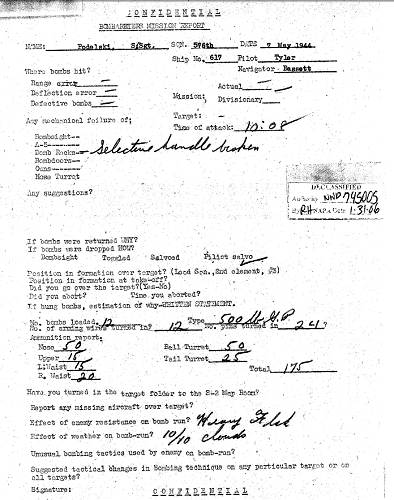
26 Mission Report
Click image for larger viewMay 8, 1944: Mission #10
Target: Brunswick (Braunschweig)
Again crews were briefed for two plans and Plan “B” was Brunswick. At 0610 twentyeight planes began take-offs. Due to 10/10ths undercast again, the results of the bombing were not observed. Flak was intense with 11 ships suffering battle damage. All returned around 1300 hours. Ace flew in aircraft #772 which suffered some flak damage. Of almost seven hours flying time, Ace flew about four hours and the Co-pilot (Ricci) flew three hours. This pattern of sharing flying time with Ricci would continue for most of the remainder of missions. After this, his 10th mission, an oak leaf cluster was added to the Air Medal. An interesting part of the 14th Combat Wing report involving the 44th BG was described as follows: “At 0852 hours over Zuider Zee B-24 with yellow rudder with black horizontal bar across rudder observed going in same direction at 11 o’clock low.
A/C later observed turning off to left. At 0902 hours at 52 deg. 37’N. 05 deg 38’E., yellow barrage balloon observed at 2000 ft. Two chutes seen over target. At 1027 hours
52 deg. N. 10deg. E., 2 B-24s from another group seen to collide, one exploded and both seen going down-3 chutes observed. At 1125 hours shortly after crossing the coast out at
52deg 42’N. 04deg. 38’E. B-24 ahead seen turning off to left. P-51s heard over VHF saying they were coming back to identify this A/C. A/C heard replying, “No, you’re not.” After this P-51s were seen shooting this B-24 down.” Evidently, this was a captured B-24 which had flown along with the group for some time. There were some attacks by enemy fighters, with the 392nd destroying one. The attacks on other groups, however, were much more severe, with the 389th claiming 17 enemy planes destroyed.
May 9, 1944: Mission #11
Target: St. Trond Airfield
A late Field Order was received at 0200, so briefing was quickly held between 0245-0315 hours for 28 crews. At 0605, the planes began take-off. Upon reaching the target,
(1358) 100 lb. bombs were released with excellent results. No enemy aircraft were encountered and flak was light, although some planes suffered minor damage. Ace flew “tail-end Charlie” of low left group in #136 (on Lt. Ellison’s right wing). This mission was flown with a crew of nine. The 392nd Bomb Group led the 14th Combat Bomb Wing with three squadrons and the 44th Bomb Group was second with two squadrons. The first squadron of the 392nd laid down a very good pattern on the briefed target, getting excellent results. The third squadron (Ace’s squadron) laid down an even better pattern with excellent bombing results while the second squadron laid down a very poor pattern short of the briefed target, accomplishing fair results.
May 10, 1944: Mission #12
Target: Diepholtz
This mission was to be against an airfield in Diepholtz. Due to extremely poor assembly weather, however, the mission was scrubbed. Ace had to abort this attempted mission because of a malfunctioning radio. According to the Ind. Flight Records, he was given credit for a sortie and a total of five hours flying time was recorded.
Records indicate there were several days before flying again. On May 14th , Ace was listed as flying 1:15 with another crew. I assume that this was a training flight for a new crew. On May 20th, Individual Flight Records indicate 3:25 flying time, which was probably a training flight, since there was no group mission record for that day.
May 23, 1944: Mission #13
Target: St. Avord Airfield
Briefing was held at 0130 with 30 aircrews. At 0500, thirty planes took off under good weather, for a change. Bombing results were excellent. No fighter reaction was encountered, but flak was moderate and fairly accurate. Nine planes were damaged, but there were no casualties and planes returned to base about 1300. Ace’s plane was #136 and again flew low left tail-end. Below is a photo of the bombing results of the two 492nd squadrons. One can see that the smoke is coming up in the target area. Just above this the runways are visible (photos 27 and 28).
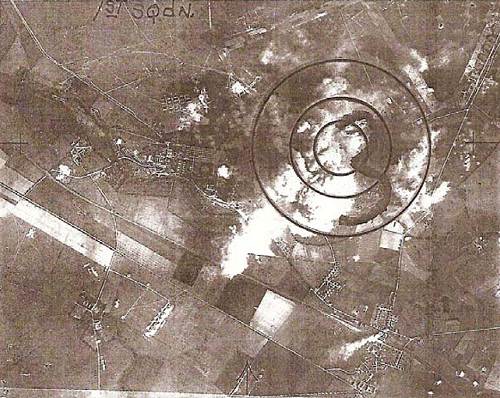
27 Bombing Run
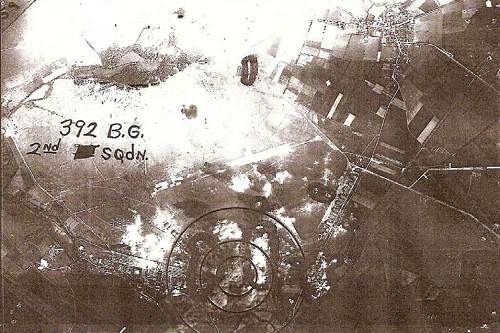
28 Bombing Run May 24, 1944: Mission #14
Target: Melun Airfield
The mission of May 24 was scheduled for Melun Airfield. Ace, flying in #045 was forced to abort this mission due to aileron control sticking. Individual Flight Records indicate, however, that he was given combat credit and actually put in 3:25 flying time as part of the mission. After aborting, he evidently flew additional time checking out the controls since records indicate 4:30 flying time with two landings. The groups bombing was very successful and no enemy fighters were seen. Flak was moderate but inaccurate with 11 planes having some damage. No casualties were suffered and they returned to base around noon. The report of the aborted aircraft is shown below (photo 29).

29 Aborted Aircraft Report
Click image for larger viewMay 27, 1944: Mission #15
Target: Saarbrucken
A total of 24 planes went over target and the bombing run was very successful. No enemy planes were encountered. Flak was fairly accurate and 11 planes were damaged but there were no casualties. All aircraft returned about 1845 after a mission of over eight hours.
Ace’s plane was #136 and suffered some flak damage. His position in formation at the target was the left high block. A second oak leaf cluster would have been added to the Air Medal after this mission.
May 28, 1944: Mission #16
Target: Zeitz
The synthetic oil plant near Zeitz was the target. At 1044 hours 26 aircrews took off. Bombing results were excellent. Nine aircraft suffered minor damage and there was one casualty. Ace flew in aircraft #433 and was high and right of the 44th group in formation. All planes were back around 1800 hours.
May 29, 1944: Mission #17
Target: Politz (Stettin)
Again the oil refineries were the target as an increased effort was being made to reduce Germany’s capabilities prior to D-day. It was the first raid on Politz, a heavily defended target. This was the location of Germany’s largest synthetic oil refinery at this time. Four B-24 Combat Wings (439 planes) took part in this operation. This would turn out to be the fourth most costly in planes and seventh in personnel casualties for the 392nd. At 0749 twenty-seven planes took off from Wendling. One plane was forced to abort due to mechanical problems. Just prior to reaching the target, an estimated 75-100 enemy fighters attacked the group. These included ME-109s, FW-190s, JU-88s and at least one twin-engine ME-410. The fighter attacks lasted for about thirty-five minutes and started 50-75 miles before reaching the target.
Formation after assembly and over target are shown in the following two diagrams (photos 30 and 31):

30 392nd Bomb Group Formation
Click image for larger view

31 392nd Bomb Group Formation
Click image for larger viewAce’s plane was #136 and was positioned at the tail end on the right of the lead group. The enemy fighters were well-coordinated in mass attacks through the formation and also shot rockets into the formation from the rear. According to eyewitness reports, Ace’s plane was seen under fighter attack at 1212 hours and had two engines (out) feathered. It appeared to roll over on its back and went into a steep dive from an altitude of 21000 ft. One chute was seen from the plane. This was the Navigator, Earl Bassett.
In a conversation with his wife in 1999, she told that he landed near the railroad and was taken prisoner by the local police. In an interrogation report in 1945, after being released from prison camp, Bassett corroborated the report of how the plane went down. Bassett had related to his wife that there had been a fire, likely an oxygen fire. The main reason Bassett was able to get out of the plane was the Navigator is closest to the hatch used for escape and it is only large enough to barely squeeze through with a chute on. The other means of escape from the plane was through the bomb bay doors. Earl Bassett returned to live in Rhode Island after the war and died in 1997.
The Stoltz plane (045) was positioned just in front of Ace’s plane and also went down at about the same time. No chutes were seen. Evidently, this plane was able to recover somewhat, because the crash site for this crew was 60-80 miles west of Gueltz. One report indicated that it was headed to Sweden. It crashed however at 1240 and all the crew were killed. It is likely that German fighters attacked it since it was already a damaged plane. The Eiserman plane (604) crashed near the Baltic Sea, after the bomb run, and 8 chutes were seen. It was later reported that all the crew were taken prisoner, but one later died. The Larson plane (243) also went down and 7 chutes were seen. Final reports, however, indicated that all 10 crew members were KIA. Three of these were killed on the ground by police or citizens. Two other planes crash landed in England and the crews were safe. Eight other planes had battle damage-some severe. One plane returned with two engines out and the nose turret blasted apart.
The narrative of the command pilot seems to agree with other reports about when the four planes went down at or near the target. He indicated that the first plane to go down was that of Larson. This occurred about 20 minutes prior to release of bombs over target. The Eiserman plane went down about 1209 after releasing bombs. The Stoltz plane and Ace’s plane went down about the same time (1212), which was over the target and about the time the lead navigator reported bombs were released. So it is probable that bombs had been released over the target, but since they were under attack, they may not have been.
Evidently, Ace’s plane was hit during the first of three waves of attacks of fighters. According to some witnesses, there was no Allied fighter support until after the target and the enemy fighters had left. This was likely due to a timing error in arrival of the fighter escorts. Reports of the 2nd Air Division, however, indicate that the two leading combat wings going to Politz were first attacked by approximately 40 FW-190s. Those were engaged by one Squadron of the escorting P-51 group. Immediately thereafter, and in the vicinity of the Initial Point, a second formation of approximately 60 single-engine fighters operating in two waves intercepted the same two Combat Wings as another formation of 20 enemy aircraft attacked one of the P-51 squadrons. These concentrations quickly saturated the defense afforded by the one P-51 Group (42 aircraft) and enabled a large proportion of the enemy fighters to engage the leading Combat Wings without opposition as they continued through the target area at Politz. So while one enemy fighter group was attacking the P-51 escorts, the second enemy fighter group was left to attack the bombers without opposition.
According to the German reports (see copy of report which follows), the recovery of bodies from Ace’s plane occurred at Gueltz near Demmin and they were buried at Gueltz, 800 meters from Gueltz-estate. Ace’s body was placed in grave #5. “Dog-tags” of Ace, Bassett (taken prisoner), Podolski, McDonald, Troutman, and Blaida were returned in German files and are located in the National Archives at College Park, Md. The crash site was near the village of Gueltz, near the railroad line between Demmin and Altentreptow.
Seven of Ace’s crew had flown on the first combat mission of Mar. 16 (Tyler, Ricci, McDonald, Metz, Brown, Podolski, and Blaida). Troutman had joined the crew for several missions, but this was only the second one for Powell. Bassett was not the Navigator on the original crew but had flown several missions with this crew. He was part of the original Ellison crew.
There is some inconsistency in the German reports and later casualty reports. The German reports list Corbett Miller as one of the casualties, however later reports do not list him. He had been injured on the mission of April 22 and did not fly again. It is likely that since there was a copy of Sgt. Miller’s pay record found on the plane or on one of the bodies (this was included in German files), they assumed he was one of the crew. The actual German report does say “probably” Sgt. Corbett Miller. Powell was likely the replacement for Miller. Another factor that contributed to this confusion was that Joe Ricci’s confirmation of death did not occur until much later (probably due to difficulty in identifying the remains). So his body may have been mistakenly identified as Miller’s by the Germans.
Further details of the crash were learned through correspondence with individuals from the Gueltz vicinity and through a visit to that area in October, 2003. This information is given in a separate section later in this journal (The Crash). Also, other details about the crash were gathered through the Individual Deceased Personnel File.
In order to further elaborate on this specific mission, however, I have chosen to use the description given by Lt. Ellison to show, from his perspective, what happened during this mission to Politz. These are the words of Lt. Ellison:
“On May 29, our 28th mission was almost our last. At briefing the target was named Stettin, an oil refinery northeast of Berlin. A long, long haul! In later documents I noted that this target was called Politz. Anyway, it is the same place. We flew this one with two of our old crew missing, Hurdle and Bassett. Hurdle, having flown as squadron bombardier several previous missions, had completed his tour and was being transferred. Bassett had been assigned to Lt. Tyler’s crew for this mission. I had a replacement enlisted man in the nose turret and he was scared almost to death. The timing must have been off for we missed our fighter escort and it is just what the Luftwaffe had been waiting for. About 15 minutes from the target and for approximately 30 minutes thereafter, we were under attack by 100 to 150 FW190s, JU88s and ME109s. During the first three attacks the ME109s and FW190s went through the formation and between the B-24s, thereby creating havoc. They literally shot the 392nd to pieces. German pilots came so close that I felt as if I would recognize them if I met them on the street. We lost six to eight of the 27 planes we started with and I thought that we would be among the missing that night. One 20mm came through the front windshield and missed my head by a small fraction of an inch, went on back and ripped some clothing from Samples in the top turret. We also had 20mm shells in both spars which buckled the wings, but by the grace of God, did not ignite the fuel. Also, we had a cylinder shot out of our number two engine which made it inoperable. Number three engine was hit and running rough but I could use it about half of the time. I could not feather the propeller on the number two engine at all. The enemy fighters must have run low on gas because they withdrew.
“We were deep in Germany, plane shot up and no friendly fighters in sight. The situation did not look good. I ordered everything that wasn’t nailed or welded down thrown overboard and this included bombsight, flak vests, guns, ammunition - everything! I tried to snuggle up to another group as they passed but couldn’t maintain enough speed or altitude. Even the B-17s were passing us. I was resigned to the fact that we would be guests of Mr. Hitler that night. I flew all the way back with my hand on the landing gear lever. I meant that if an enemy fighter showed up, down would come the landing gear. And to think that we were so close to finishing 30 missions too. We lost altitude gradually all the way toward the English Channel, but we stayed in the air and no enemy fighter appeared. Finally, at about 4,000 feet we crossed the English Channel and started looking for someplace to land. We had gas and no field was in sight so we made it back to Wendling. Bassett didn’t. Tyler was shot down and Bassett was the only man to bail out before the ship blew up killing all on board. Bassett was a POW until the end of the war. As I remember, there were three major frontal attacks by the fighters and some JU99s shooting rockets at us. The FW190 that got us I know figured that he had a victory.
“Back at Wendling we were the only ship in the traffic pattern and the ground crew had given us up for lost. Our airplane was so badly damaged that it never flew again.”
Note: Alice and I visited with Lt. Ellison at his home in Lancaster, SC in 2000. He told us about this mission and showed a picture of the plane after it had returned, with the hole in the windshield he had described. His experience is typical and could describe what thousands of others went through. He related how fortunate he was.
THE TELEGRAMS
As a boy nearing 14 years old, the memory of how we received word is still very clear. In talking to Don and Alta recently, it is also a vivid but obviously sad memory for them. The Missing in Action telegram was sent to Mary Jo who was living with her parents in Kansas City at this time. This telegram was dated June 13, 1944. I assume that a telephone call to our family followed as soon as she received the telegram. In reading copies of letters from families of crew members, most of the families received the MIA telegrams on about the same date. After the initial shock, there seemed to be a common feeling expressed by most families that the crew was likely taken as prisoners and would be safe or that there was some mistake and everything would be okay. Communication to families from the authorities during this time was very restricted in what could be written and in most cases, they only know that a particular plane had not returned from a mission and they did not know whether the crew was killed or taken prisoner.
It was only less than a month when most of the families were notified that their loved one had been Killed in Action. This occurred about July 9, 1944. The Metz family however were not notified until Sept., 1944 and the Ricci family even later. This obviously was due to the confusion in identification and German reports that Corbett Miller had been on the plane the day it went down.
Copies of telegram and newspaper clippings are included below (photos 32, 33, 34, 35 and 36).
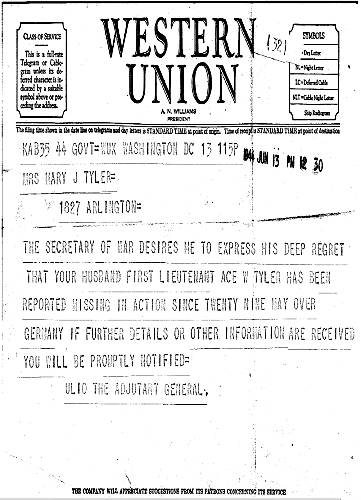
32 Western Union Telegram
Click image for larger view
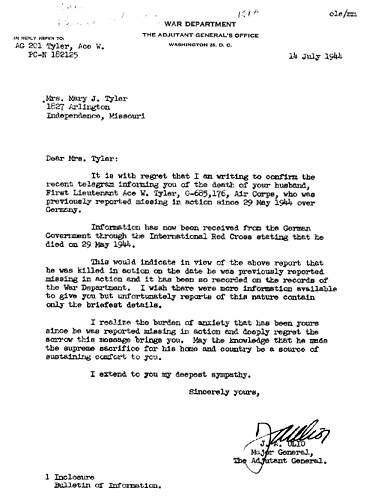
33 Letter from Adjutant General's Office
Click image for larger view
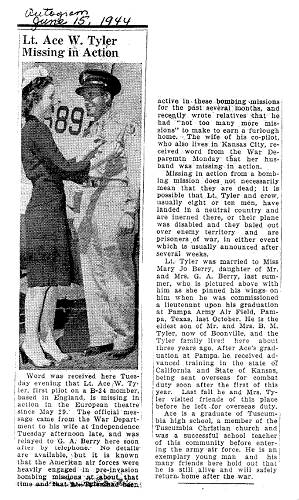
34 Newspaper Clippings
Click image for larger view
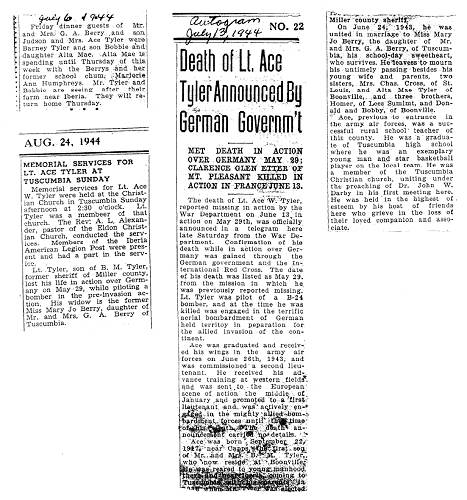
35 Newspaper Clippings
Click image for larger view
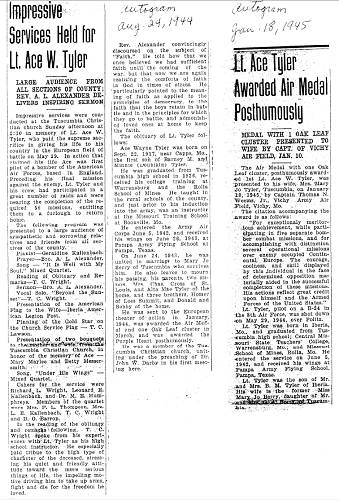
36 Newspaper Clippings
Click image for larger viewIncluded below is a letter written by a good friend of Ace’s who was in pilot training in California when he heard the news of the loss of the crew.
21 July 44
Dear Mr. & Mrs. Tyler and family,
It is hard for me to find words which will express my sympathy to you over the loss of Ace. It was very shocking news to me, too. As you probably know, we have corresponded since Ace first went into the Army. The last letter I had from him was in May. I had asked him for advice as to what plane I should fly after I finish my training. He recommended the B-24 to me very highly, and told me he had brought them in on two and three engines, and with enough holes in them to make them whistle like a sieve. I answered that letter the 19th of May and got it back the first of July marked “Missing from 576th Bomb Sqdn”. I really had a funny feeling when that came back as it did, because I knew Ace had been in plenty of the “heat”. Ace was as good a man as I ever knew, and had very high ideals. I feel as though I had lost a life-long friend, even though I have known him but a comparatively short time. It seems hard to lose a peace-loving American in war, but a good many of our boys have met the same fate, and we who are still in training can’t foretell what’s in store for us, but at least it can’t be any worse, and you can be sure we’ll be in there to get the guy who got our buddies.
Again, I say I’m proud to have known Ace Tyler and his parents.
Sincerely,
Roy E. Willey
|
THE CRASH
This section was obviously very difficult to write. I wondered, when family members later read it, whether it contained details of which they would not wish to know. My motive however, was to find out as much as I could, to discover how events occurred, and to describe how a tragedy of war affected one family. The feelings of our family were repeated thousands of times in other families and may our children, grandchildren, and all those of the future not forget the sacrifices made by the true “heroes” who gave their lives.
Details of the crash of Ace’s plane have been obtained through various sources. The last official description included only what was observed from an eyewitness from another plane in the formation. This description was that the plane was on fire, two engines out, and had turned over when it started down and only one parachute was seen. This was confirmed after the war by the Navigator (Lt. Bassett) who had bailed out.
In the summer of 2002, the search began to find out if there was further information. Through contact with Ben Jones and Jim Marsteller (both researchers on the B24.net web site) it was suggested that I contact Carsten Kohlmann, a German researcher who had assisted both Jones and Marsteller. Mr. Kohlmann promptly answered my inquiry and he contacted Ilona Hausler, who worked in the district offices in Burow which was near Gueltz and in the same district. She contacted me in the Fall of 2002 and said she had made inquiries and found that there had indeed been a crash of an American plane on May 29,1944 near Gueltz. Although she could find no official records or newspaper reports, she was able to locate some older citizens of Gueltz who had remembered the crash. One person she located was Horst Altenburg. He had been an eyewitness to the crash and had been present when the bodies of the crew were disinterred in 1946 for relocation to cemeteries in Europe. This was done under the direction of Soviet officers since this was in the East German sector at that time. According to this account, the plane had been on a “glide path” and had dropped its bombs earlier. Evidently on the ensuing landing attempt the plane crashed and there was an explosion. One crewman was tangled in the overhead electric wires not far from the train station. He was alive when found but died shortly after from injuries. The remaining crew members were found dead and were buried near the woods close to the crash site. According to this report, it appears the plane had recovered somewhat from when it had first started down, had dropped its bombs and was attempting to land in the field near Gueltz.
Following is a report of the Germans (KU 2086) about the crash and burial of crew (photos 37 and 38). The original German files were confiscated at the end of the war. The reports are given in German first, followed by the translations.
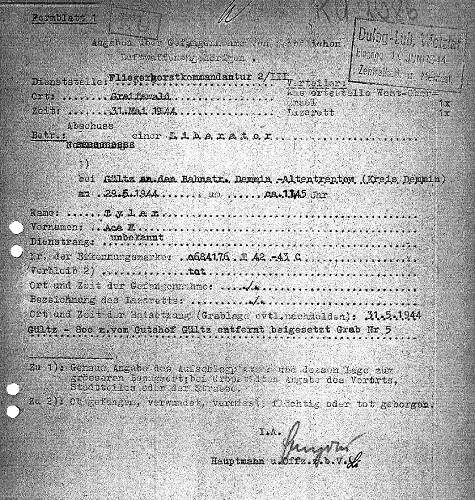
37 German Crash Report
Click image for larger view
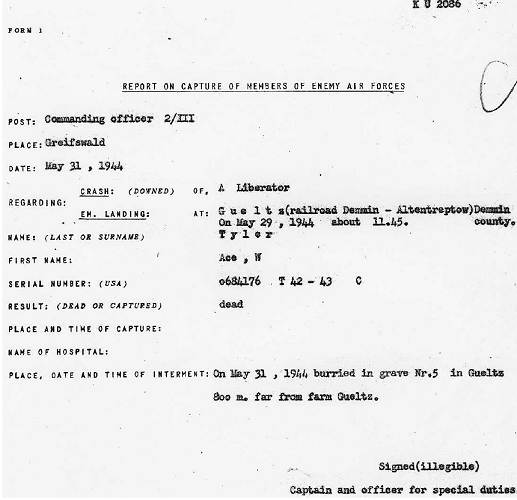
38 German Crash Report Translation
Click image for larger viewHere is the copy and translation of the original telegram notifying authorities of the downed aircraft, nine dead crew members and the one prisoner (photos 39 and 40).
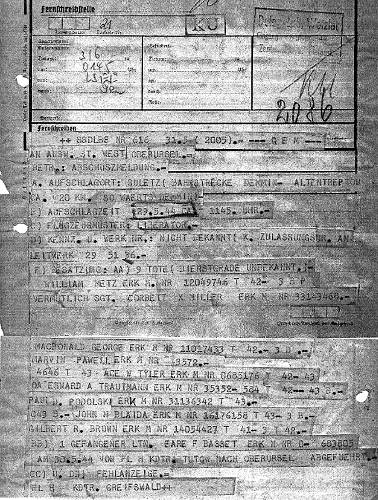
39 German Telegram
Click image for larger view
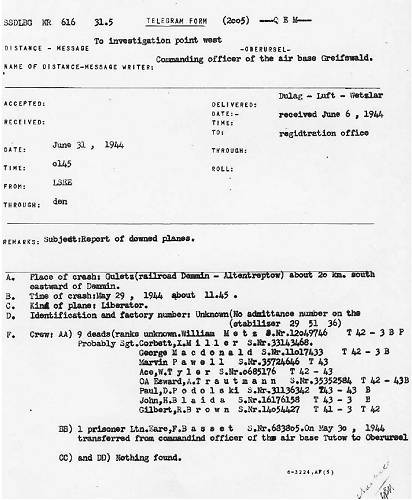
40 German Telegram Translation
Click image for larger viewNote the inclusion of Corbett Miller in the list of dead crew members. As indicated earlier he had been injured on the mission of April 22 and was not on the mission of May 29.
The following is essentially the same information in a different report (photos 41 and 42).
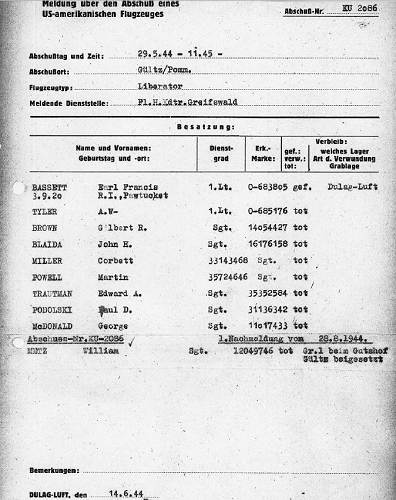
41 German Crash Report
Click image for larger view
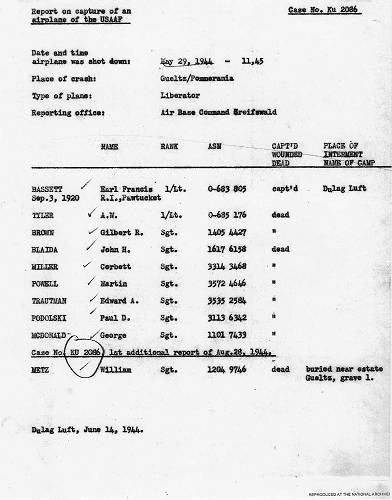
42 German Crash Report Translation
Click image for larger viewAnd here is the “Report on Captured Aircraft”. This identifies the plane and describes the salvage operation (photos 43 and 44).
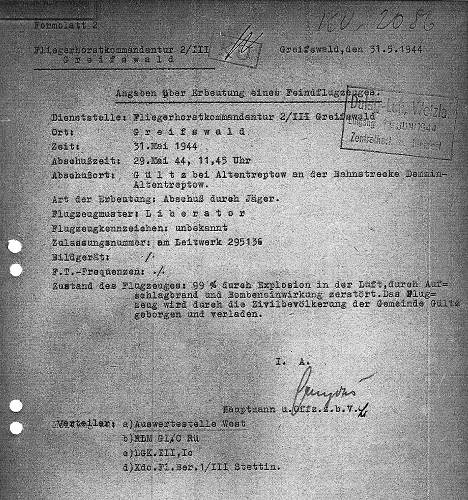
43 German Report on Captured Aircraft
Click image for larger view
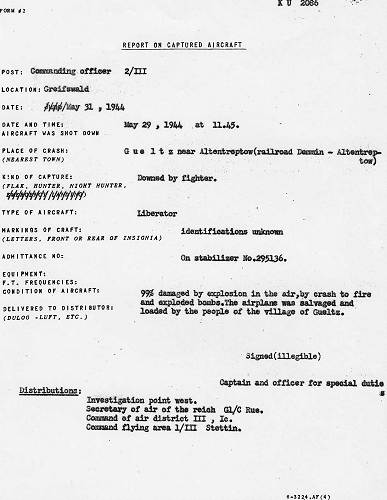
44 German Report on Captured Aircraft Translation
Click image for larger viewThe following are copies of the “Missing Air Crew Report” generated by the U.S. Air Forces (photos 45 and 46).
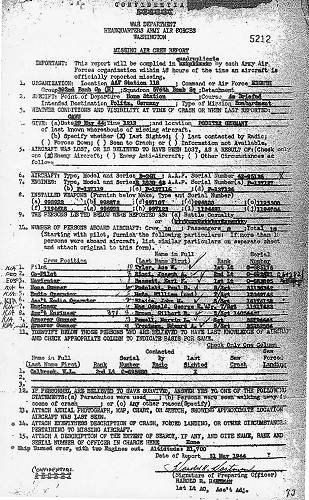
45 U.S. Air Force Mission Crew Report
Click image for larger view
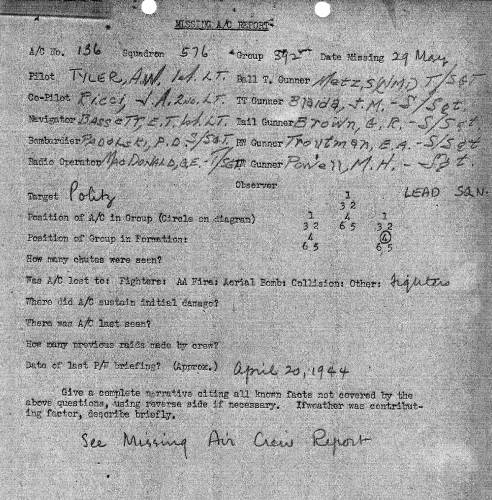
46 U.S. Air Force Mission Crew Report
Click image for larger viewOne of these was filed for each crew member. The copy for Ace is shown below (photo 47).
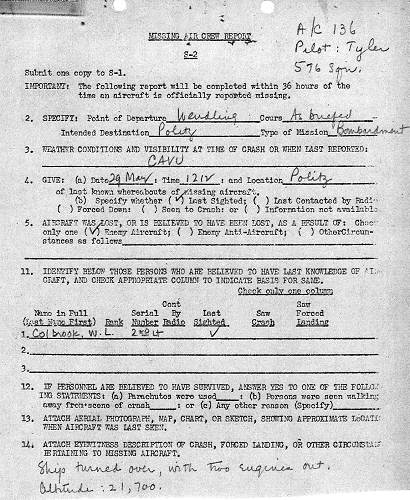
47 U.S. Air Force Missing Air Crew Report for Ace
Click image for larger view
Visit to Crash Site
Following the initial contact and exchange of letters and e-mails, it was planned that Alice and I would visit the crash site in Germany. On October 24, 2003 we arrived in the village of Burow where we met Ilona Hausler in her office. She had one of her assistants drive the three of us to Gueltz, which was about 6-7 miles away (photo 48).
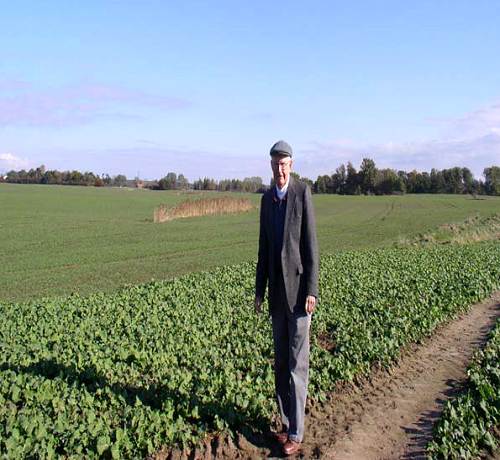
48 Bob Tyler at Crash Site - Oct. 24, 2003
The high grass was the spot where crash occurred There we met a resident of Gueltz at the crash site. It was only a short distance from the edge of the village. The resident, Herr Rhode was eight years old at the time of the crash and he related how he had carried food to his father who was helping to move the pieces of the plane on wagons to be taken to the train (photo 49).
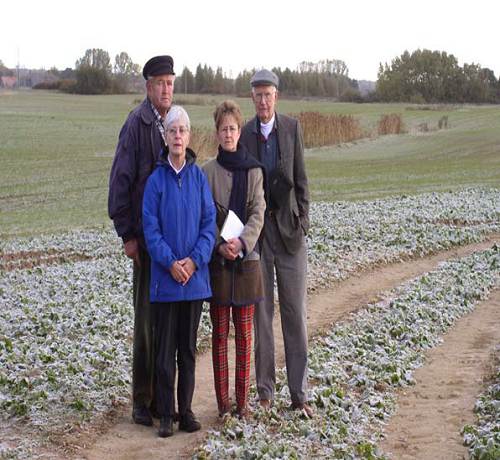
49 Herr Rhode, Alice Tyler, Ilona Hausler and Bob Tyler An event such as this was firmly etched in the memory of the young boy and he told us what he remembered being told about it and his own experience. He said that the plane was on fire and two parachutists were seen. This is the first we had learned that there may have been more than one parachute visible. Herr Altenberger (previously mentioned) was present in 1946 when the bodies were exhumed and taken to a military cemetery in Belgium. Since this was in East Germany at the time, a Russian Officer was in charge of the exhuming. Herr Altenberger had initially indicated he would meet with us but later decided that he did not wish to do so. Herr Rhode said there were two ladies who still lived in the village who remembered the crash. We were not able to talk to them. Frau Hausler said there was at least one lady in the village who had taken flowers to the graves of the buried crew. She indicated this was very unusual because people were afraid that government officials would not approve and that other villagers might disapprove. Herr Rhode said that the burial had been under the direction of the German Military (photo 50).
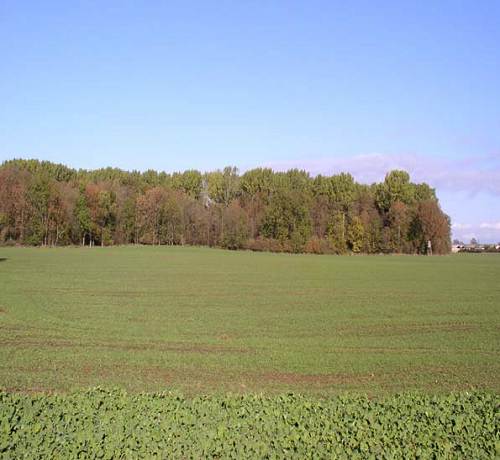
50 Burial Site was along edge of woods in Background No accounts in historical records, newspapers, etc. were found. Herr Rhode said he remembers seeing planes (bombers) flying over and was impressed by how many there were. He also recalled seeing the German fighter planes attacking them.
After talking to Herr Rhode and seeing the crash and burial site, we returned to the office of Ilona Hausler in Burow. We were grateful to Herr Rhode for talking to us. We were very grateful to Frau Hausler for her organization of the visit and her willingness to be our interpreter. She had arranged to have refreshments for us in her office and while there she called a reporter who wanted to come to talk to us and take pictures. After the reporter had interviewed us, she accompanied us back to the crash site where pictures were taken. The reporter, Christine Weinreich, indicated her article would appear in the paper the next morning. She told us she would bring a copy to our hotel in New Brandenburg. We had to leave the hotel rather early to meet a train back to Berlin and missed her. While waiting on the platform for the train, however, she came running up to us, waving the paper. She waited with us until the train came. The hospitality of the people there was great and we were very appreciative.
Here is a copy of the article written about visit to Gueltz and the crash site in Oct., 2003 (photo 51):
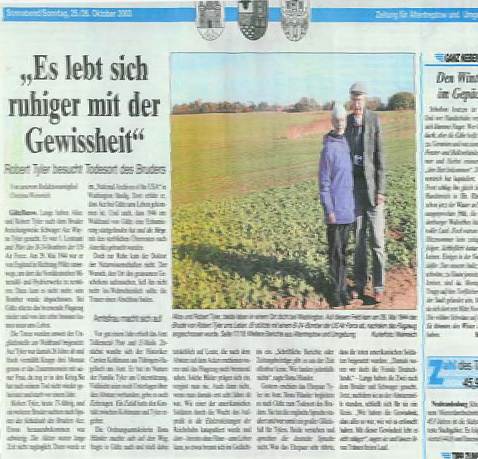
51 Newpaper article about visit to Gueltz The following is a rough translation of the article appearing on the previous page (photo 51a).
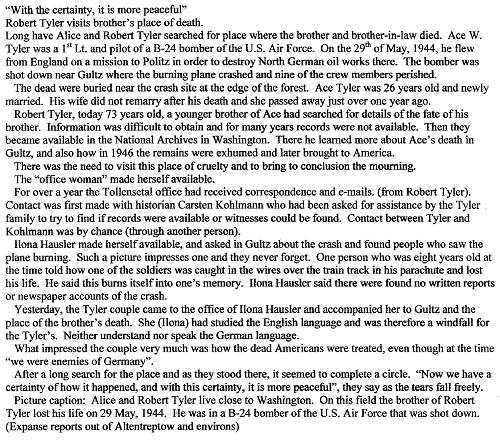
51a Newpaper Article Translation
Click image for larger viewIn 2006, some additional information was obtained about the plane crash. This was learned through material included in the Individual Deceased Personnel File, which was requested from the U.S. Army Resources Command. This was only the file for Ace, however, additional files for other crew members have been studied and they contain the same information about the crash. In the report, titled “Report of Investigation Area Search” dated 19 September, 1947, the site and date of burials is given. It also indicated that Italian prisoners of war made the burial and were supervised by an Italian prisoner who was a Chief Petty Officer. As a witness, his statement about the crash was as follows:
|
“I, chief petty officer, living at present, with my family at S. Giacomo No. 271, Cavour, Province of Turin, returned in these days from Germany, feel obliged to send to the American Military Command of Turin this witness, for the purpose of facilitating the search for heroic aviators, crashed with their own plane, while fulfilling their mission, near to the factory, in which I was working, while prisoner. On the 29 May 1944, at about midday, a very big formation of four motored American planes flew through the sky, coming from South and going, probably in direction of Stettin on an aerial flight. A four-motored plane dropped the bombs in the vicinity of the factory. Afterward, a four-motored plane showed some flames from the motors on the left. Then three (3) parachutes were to be seen descending, one (1) of them dropped almost at once, also another descended very quickly, and the third descended very slowly. In the meantime, the plane crashed, for about 800 or 1000 meters, it seemed to rise again, turned round, then crashed again with big roar, and it caught fire. Our watchman with some of us ordered us to return to the factory. The following day, with permission of the Baron, were composed the remains of the seven (7) men remained in the plane, we found the two parachutists a little further away with the parachutes, the third saved his life and as prisoner was brought to Seltz, munition depot 2 km away. Everything was arranged for the preparation of a cemetery, near the woods, in the field where the plane crashed. For each grave was put a little cross, and on it the identification tag belonging to each, later on some plates were placed on the graves. French and Italian prisoners took care of these heroes in a furtive way. It was impossible for me to take a number or the registration of the plane. The cemetery is located about 1500 meters on the left of the R.R. Station of Gultz-Pomerania, on the line Berlin-Stralsund at about 154 km North of Berlin, now this zone is occupied by the Russian troops.
Destination: Gultz-Demmin-Kreis Stettin-Pommerania-Germany.”
|
The above statement is copied as written by the witness.
In the process of the investigation, two citizens of Gultz were interviewed:
“Narrative of Investigation”
“Contacted Burgermeister Wilhelm Wolf and Helene Sodmann. Stated that on 29 May 1944 a plane crashed near here and seven men were found in the wreckage. Three had jumped out but 2 parachutes failed to open and they were found some distance away. The third was taken prisoner. The nine bodies were buried in an edge of woods near the scene of the crash and crosses erected over them. Identification tags were fastened to the cross but some of them were later removed.”
“Eight of these nine men are listed on MACR FF 220. The ninth man is identified as Sgt. Corbett X. Miller, 33143468. The ninth missing man on FF 220, Lt. Joseph A. Ricci, cannot be located.”
The above information from the investigation appears to clarify some points in regard to the crash. These are: (1) The plane had dropped bombs prior to crashing; (2) Seven crew members were in the plane when it crashed; (3) Three were able to parachute out, but two parachutes did not open; (4) The plane was on fire in the air; (5) The plane exploded and burned on the ground; (6) The plane may have been attempting a crash landing (earlier witness mentioned that plane was on a “glide path”).
Disinterment and Reburial
On July 15, 1947, the bodies of the nine crew members buried near Gueltz were disinterred and taken to the U. S. Military Cemetery, Neuville-en-Condroz, Belgium for reburial. The narrative of disinterment indicated that the bodies were clothed in the electrically heated flight suits and fur lined boots. The remains had been buried without coffins but were easily separated because of an eighteen inch space between bodies. A cross was erected on each grave, five of which had the identification tags nailed to them. The other four having the names and serial numbers on them.
Prior to reburial in Belgium, positive identification was made on the body of each crew member. This identification process was very detailed and complete, including comparison of dental records. The date of the reburial in Belgium was Nov. 25, 1947.
In correspondence between the U.S. Government and Mary Jo, it was determined that it would be her choice that Ace’s remains would be returned to the U.S. and buried in the family plot of the cemetery in Iberia, Mo. Disinterment occurred from the Belgium cemetery on Dec. 7, 1948. The body arrived in Crocker, Mo., by train, on May 26, 1949, and was transferred by the Adams Funeral Home hearse to Iberia. A military escort accompanied the body until its arrival and remained until a memorial service was held on May 28, 1949. Following are pictures showing the casket with escort and the burial service (photos 52 and 53).
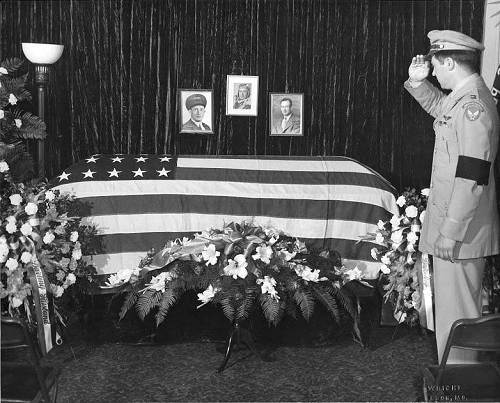
52 Ace's Casket with Escort

53 Burial Service
THE CREW FAMILIES
When the decision was made to write this journal, it was believed that some contact with families of crew members would be helpful. Attempts were made to contact as many surviving family members as possible. In most cases, this was very difficult, and in a few cases, I have not been successful. The crew positions are listed as indicated on the last mission. In the case of many of the gunner positions, these were often somewhat interchangeable, particularly the waist gunners and top turret.
Earl F. Bassett, Navigator: When I first started researching this story, I tried to contact Earl Bassett, since he had been the lone survivor. Since I knew his home address had been Providence, R.I., I used a computer search and found a phone number which I called in 1999. I talked to Ruby Bassett, his wife, and she told me that Earl had passed away about two years earlier. She related to me events regarding the crash as she had been told.
One thing she indicated was that when her husband left the plane, he threw a parachute to either the bombardier or one of the gunners and said “follow me”. As indicated by the deceased personnel files, there was one and maybe two others who parachuted out, but did not survive.
She also gave me the address of B. F. Ellison, who was the pilot of the first mission Ace flew as a co-pilot. This mission was to Erkner, near Berlin, on Mar. 8, 1944. I made contact with Ellison and will include that at the end of this section.
Following is a letter from Earl Bassett to Mary Jo written after the war.
Houston, Texas
October 26, 1945
Dear Mrs. Tyler:
I don’t know quite how to begin. I know that it has been a long time since I returned to the States and this moment has been dogging me ever since, but I must write and let you know the few meager details as I saw them.
There isn’t much I can add to what you already know. First of all, we were headed for Stettin and underwent an attack of enemy fighters, possibly forty or fifty. They had already gone through us once and were returning from the rear, when we were hit by a 20 millimeter shell on the right side of the ship between the nose and the leading edge of the wing, very close to the co-pilot’s seat. This hit shot out our oxygen lines and started a blazing inferno, fed by oxygen. The co-pilot, Lt. Ricci, and your husband must have been wounded, possibly fatally, and must have been straining to keep the ship at a level keel. At this time my clothing was burning furiously. I had no actual contact with the rest of the crew for our communication system was also shot away, so I had to abandon the ship.
From my personal experience with the crew you can rest assured that no cowardly action was taken by any of them. They all died a hero’s death, and nothing can be said in their behalf which would overate their deeds. I was lucky in escaping their fate, merely lucky.
I really wish that I could see you all personally for I feel that it is my duty to give you the details which are due you. By being the only survivor, I find that my job is thereby increased tenfold. Again, I say that I am sorry that I haven’t written sooner, but unpleasant tasks seem to be so easy to put aside.
I am now stationed at Ellington Field, Texas, which is eighteen miles south of Houston. If by any chance you are in the vicinity, please feel free to call upon me. My address in town is 614 Fargo, Houston, Texas.
Sincerely yours,
Earl F. Bassett
1st Lt. AC
|
Raymond J. Carley (original crew Navigator) and Melford H. Butts (original crew Bombardier): For some time it was a mystery as to why Carley and Butts were not included on the missions of Ace, since they had been original crew members. After talking by phone with the widow of Mel Butts, and later finding information in a letter from Ace, it was learned that they had both volunteered for a mission on March 6, 1944 and were taken prisoner after their plane was shot down. They were on a mission to Genshagen with Hestad as the pilot. It was learned that this ship was hit by flak and dropped back from formation, bombed the secondary target and then attempted to return to base. It was attacked by fighters twice near the German-Holland border. The plane crash landed and all 10 crew members were taken prisoner. A picture of the plane after crash landing can be seen on b24.net.
As indicated, Mel Butts passed away in 1990, some time before I contacted his widow. I was not successful in locating family of Ray Carley.
Corbett Miller, Tail gunner: Miller was not on the mission of May 29, since he had been injured on the mission of April 22 to Hamm. In the fall of 2002, Alice and I drove to Rockwood, PA, the listed home town of Corbett Miller. Being a small town, it didn’t take long to find someone who knew Corbett Miller. Unfortunately, he had died in 1969, at the age of 58. After talking to several of the older residents who had known Corbett, I was able to locate Corbett’s nephew who lived in Somerset, PA. He told us stories he had heard passed down about Corbett. In regard to the mission on which he was wounded, he was bleeding badly and his blood froze to the turret, causing them to have difficulty in taking him from the plane. His wounds to his back and hip were severe, and according to his nephew, he never completely recovered from them. His nephew indicated that “Corby” always felt he let the crew down by not being with them on the last mission, and thought they could have survived had he been there. Since Corbett joined the crew later, his picture was not included in the crew picture. Below is a picture given to me by his nephew Lon Schrock (photo 54).

54 S/Sgt. Corbet X. Miller The following transcript of letter from Corbett Miller to Mary Joe indicates to me the character of this man.
Aug. 31, 1944
Dear Mrs. Tyler,
Enclosed find money order for $24.00. This is the amount our crew saved in pennies for a good time. I didn’t know what to do with it; so I held a drawing and Lt. Tyler won it.
I have never heard from any of the crew; except what other crews told me that were flying with them May 29. I can’t tell you anything; but the news seemed rather favorable.
If you know or have heard anything I would appreciate it if you would write and tell me.
Thanking you in advance
Yours truly,
S/Sgt. C. X. Miller
|
Joseph A. Ricci, Co-pilot: The family of Joe Ricci was from Georgetown, Colorado, during the time of W.W. II. I have copies of some letters that were written from Joe’s father, A. J. Ricci, to Homer in 1944. The family of Joe Ricci were the last of the families to hear that Joe was killed in action. Mr. Ricci had understandably become very upset that he could not learn what had happened and he was angry that Earl Bassett, being the only survivor was so long in contacting any of the families after the war. It is likely that the body of Joe Ricci was mis-identified by the Germans, since he was not included on the list of bodies removed and buried. They instead listed the name of Corbett Miller, who was not on the flight. This was likely due to their having found a pay record of Miller (included in the German KU files), and assumed that the body of Ricci was that of Miller.
Alice was in Colorado visiting friends and tried to call the person believed to be a sister of Joe Ricci, but was unsuccessful. Since that time, I have tried to contact Joe’s sister, Irene (Mrs. K. E. Nelson), last known address in Denver, Colorado, but have been unsuccessful.
John H. Blaida, Top Turret gunner: Blaida’s home town was listed as Monroe, Michigan. In January, 2006, I was notified by Annette Tison, researcher for the b24.net website, that a query had come in from a nephew of John Blaida. His name is Richard Wryobeck. I made contact with him and sent him pictures and other information. Below is a picture of John Blaida (photo 55):

55 S/Sgt. John H. Blaida
Paul D. Podolski, S/Sgt., Bombardier: The home town of Paul Podolski was listed as Dedham, Massachusetts. In 2007, I contacted a William Podolski in Dedham (Paul’s father was named William). The person I contacted was a brother of Paul Podolski. He said that there were 6 boys and 1 girl in the family and gave me the phone number of another brother, Alfred in Florida. After also talking to Alfred on the phone, I sent copies of pictures and documents to him. Alfred wrote me a very nice “thank you” letter, indicating that this was the first time he had seen the crew picture and other documents. I was happy that I had been able to share this with him and his family. He indicated that Paul was called “Spud” by the family. Alfred was serving in the South Pacific when Paul was killed. Evidently there were four brothers serving in the war at this time. It was helpful to me that he identified Paul in the crew picture as the second from the left in the back. According to Paul’s brothers, he had been given credit for downing two enemy fighters, although official records show only one. With my permission, Alfred gave copies of the materials I sent him to the Dedham Historical Society and a letter of appreciation was sent by the Director of the Society.
Edward A. Troutman, S/Sgt., Tail Gunner: I had written to local newspapers in Valparaiso, Indiana, the hometown of Troutman, to inquire of family. I did have the name of a sister, Berdena Bloch, but was not able to get any response. In October, 2008, however, an inquiry was made to the B24 web site asking about information concerning S/Sgt. Troutman. Annette Tison forwarded the inquiry to me and I was able to contact a niece of Troutman and her husband who live in Glendale, Arizona. Their names are Doug and Jan Whitson. After many e-mails and phone calls back and forth, I have sent information to them, and Annette Tison and I have suggested things they may do to get more information. It is always good to hear from family of the crew after so many years and I am glad to share information I have with them. Sgt. Troutman evidently became the tail gunner after Corbett Miller was injured on April 22. Troutman flew on missions of April 27, May 7, May 8, May 24, May 27, May 28, and May 29.
Of the original crew members, I have been unable to locate families of George MacDonald, William Metz, and Gilbert Brown. The last known addresses for them were as follows:
George MacDonald, T/Sgt., Radio Operator, Holyoke, Massachusetts.
William Metz, T/Sgt., Ball Turret Gunner, Teaneck, New Jersey
Gilbert Brown, S/Sgt., Tail Gunner, El Paso, Texas
The one remaining crew member who was killed on the last mission was Martin Powell, Ball Turret Gunner. Powell was from Evansville, Indiana. I had the name of a sister of Powell and wrote to people in that area with the same last name, but have received no replies. I also wrote to local newspapers requesting information, but received no response. Powell evidently flew only two missions with this crew, May 28 and May 29.
I am including information about Lt. Burrell Ellison at this point since he was the pilot of the first combat mission on which Ace flew (as co-pilot) on Mar. 8, 1944 to Erkner near Berlin. I first made contact with Lt. Ellison in late 1999. His home is in Lancaster, S.C. In 2000, Alice and I visited Lt. Ellison in his home in South Carolina. We shared photos we had taken in Wendling, England in May, 2000 and he showed us his pictures of his war experiences. It was particularly interesting to see the picture of his damaged plane from the Politz mission. The visit was very enjoyable and I was thankful to be able to talk to someone who had flown with Ace. Unfortunately, Lt. Ellison had suffered several strokes and his speech was somewhat impaired. His mind was excellent, however. Two pictures which follow were taken in 2000 on our visit to Ellison’s home (photos 56 and 57).

56 Visit with Lt. Burrell Ellison - 2000

57 Visit with Lt. Burrell Ellison - 2000
Visit to Wendling Air Base in 2000
In late May, 2000, Alice and I went to England to visit the air base where Ace was stationed with the 392nd. We thought the weather during this time would be good, however, it was very cold and rained and sleeted with strong, cold winds. I think it gave us some idea what the weather was like in the Spring of 1944 in East Anglia.
Although the Air Base was named Wendling for a village about two miles away, the base was actually next to the village of Beeston. The railroad station was at Wendling, therefore they named the base for that. One of our first stops in Beeston was at a small store where I asked if there was someone who lived there that had been there during the war. They immediately told me where Ernie Parke lived and said he was the one to talk with. We spent most of the afternoon with Mr. Parke and his wife. He had been a boy about my age at that time (14) and worked on the base doing different jobs. So he had a lot of stories to tell. He indicated how noisy the airfield became when the planes were leaving for a mission. One can imagine with more than two dozen planes taking off on most missions, there was a lot of noise. I imagine the villagers did not sleep much after four or five AM each day. His house shows how he still feels about the U. S. airmen and their planes, since he had on display several B-24 models both indoors and out. He had made friends with many of the airmen and after the war kept in touch with some of them. Mr. Parke and others we talked with during our visit expressed how grateful they were for the U. S. Airmen and the sacrifices they made. The memorial and the surrounding plot of ground was established in memory of those airmen that served there and particularly for those who had lost their lives (photo 58).

58 The 392nd Memorial at Wendling The following pictures are from our visit to Wendling and other pictures of the base in
1944 and in 2000 (photos 59, 60, 61, 62, 63 and 64).

59 Inside wall of Officer's Club

60 Outside of Used Car Dealership

61 The Parkes

62 Sign at Beeston

63 Remains of a Quonset Hut

64 The Washroom
Planes that Ace flew on Combat Missions
There seemed to be the conception that an aircrew was assigned to one specific plane and most always flew that same plane on missions. It was also assumed that the crews gave their plane a specific name. There were found two statements made by Ace in letters indicating the possibility of naming their “ship”. In a letter to Mary Jo dated Jan. 26, 1944 written from Africa, Ace said the following:
“Am across the “Pond” somewhere in Africa and still on the move. The trip has been uneventful so far. We got a picture painted on “IT” and call her “TUFFY” ha. It was the boys’ idea. Under my window the words “Jo’s Ace” stand out like a neon sign“. So it appeared that they had a picture painted and the names of “Tuffy” and “Jo’s Ace.”
After arriving at their final station in Wendling, however, they must not have had this plane. In a later letter to Homer, Ace said something about their “ship” and asked what he thought of the name of “Queen Mary” for the ship (named for Mary Jo). No evidence was found that this actually happened. When one thinks of the damage, repairs, and crew substitutions, it would be very unlikely that most crews would fly the same plane most of the time. The records indicate that Ace flew eleven different planes on seventeen missions. Two of these missions were aborted due to mechanical problems. Some of the planes were named, many were not. Following is a summary of plane numbers, names where known, and other information about the planes. The letter refers to the type of B-24 (H or J).
No. 42-7560 (H): “Blanid’s Baby” (photo 65): This was the plane of first combat mission as copilot for Ellison. The target was Erkner, (near Berlin). Ace also flew this plane on the mission of April 12 to Zwickau. This plane crash landed at Wendling on 10/20/44 after 34 missions.

65 Blanid's Baby No. 42-52670 (H): First mission as pilot. Target was Fredrichshafen. This plane crash landed near Lincolnshire on June 18, 1944, after 23 missions.
No. 42-100371 (J): “Doodle Bug”: Mission scrubbed due to weather. This plane was lost in a midair collision over the Netherlands after 14 missions.
No. 41-29131 (H): “Flying Patch ’K’” (photo 66): Mission of Mar. 26 to Febvin Palfart. Ace also flew this plane on the mission of April 26 to Getersloh. This plane was transferred to Greencastle, Ireland on 11/26/44 after completing 87 missions.

66 Flying Patch "K" No. 41-28617 (H): This plane was flown on three missions. The first was on April 22 to Hamm. This was the mission on which Miller was wounded and Podolski shot down one enemy fighter. The second mission was to Leipheim on April 24, but had to abort due to landing gear problems. The third mission on this plane was on May 7 to Munster. This plane was transferred to Greencastle, Ireland on 10/15/44 after 31 missions.
No. 42-94772 (H): The first mission on this plane was on April 25 to Wizernes. The second mission was on May 8 to Brunswick. The plane was MIA on 7/7/44 after 34 missions.
No. 42-95027(J) (photo 67): This mission was on April 27 to Chalon-Sur-Marne. This plane was shot down on June 21, 1944 after 17 missions.
.jpg)
67 Plane 42-95027(J) No. 42-7492 (H): “Hell Wagon”: This mission was on May 9 to St. Trond Airfield in Belgium. This plane completed 35 missions before being transferred to Depot on Aug. 25, 1944.
No. 42-95045 (H): “H-Hotel”: This mission was scheduled to Melun Airfield on May 24, but was aborted due to aileron control problems. This was the plane which was lost with Stoltz as pilot on May 29.
No. 41-29433 (H): “D-Dog” (photo 68): This plane was flown on the mission of May 28 to Zeitz. It crash landed the next day near Norfolk on the return from mission to Politz after 21 missions.

68 D-Dog No. 42-95136 (H): This plane was flown on three different missions. The first was on May 23 to St. Avord Airfield. The second was on May 27 to Saarbrucken, and the third and last was to Politz on May 29. It had completed 7 missions.
Note that only three of these planes were flying at the end of the war - the remaining eight had crashed.
EIGHTH AIR FORCE MUSEUM
The 8TH Air Force Museum is in Savannah, Georgia. It has many very interesting displays. One can experience a re-enactment of a mission briefing and a mission through use of actual film and audio making it very realistic. In the outside gardens of the Museum are Walls of Honor which contain names of some of those who served in the 8th Air Force and some of those who were lost. Below is a picture of Ace’s name on one of the walls (photo 69).

69 Wall of Honor at 8th Air Force Museum Also on the outside is a chapel, built to be a replica of many of the small chapels that were in England during WWII. This chapel has some very beautiful and interesting stained glass windows which depict different flying scenes. One of these is shown below (photo 70):

70 Chapel Window This museum is very well done and often has veteran flyers of the WWII era who act as guides. I have spent many hours probing them with questions about their experiences.
RIDE IN A B-24
The Collings Foundation each year has what is called a Wings of Freedom Tour. This involves their traveling all across the U.S.A. with their WWII vintage airplanes and having them available for people to view them and even ride in them. In the summer of 2008, Alice and I were on vacation in Whitefish, Montana when we accidentally happened to see a flyer advertising the Wings of Freedom Tour at the Whitefish Airport. I had planned to try to arrange to meet with this tour when it was in the eastern part of the U.S. later in the year, so we decided that was a good time while we were close to them in Montana. The planes that they have include the B-24, B-17, B-25, P-51, and some training planes. All planes are restored and flying. After we went in the planes on the ground, I decided that I would sign up for a flight in the B-24. Other than during take-off and landing, we were able to walk around any part of the plane, except entering the cockpit. Below are some pictures showing parts of the interior of the plane and readying for take-off and during flight (photos 71, 72, 73, 74, 75 and 76).

71 Ready for Take Off

72 Bob at Waist Gun Position

73 Area behind Cockpit for Engineer and Radio Man

74 Bomb Bay Area

75 From Waist to Tailgun Position

76 During Flight from Waist Window This was a thrilling experience for me to get some feeling for what it was like to fly in this plane. Although we did not fly very high, the noise was incredibly loud and the wind blowing through the open waist areas was very strong. One cannot imagine what it was like another 20,000 feet higher, about -30 degrees, in combat conditions.
THE FAMILY THEN UNTIL NOW
For family members who were not here during the early to mid-1940s, I will try to give some background information so they will better understand our family at that time. I will also cover some details of each family member’s life that future readers may find interesting or historically helpful.
Mary Jo: Ace and Mary Jo were married when he finished advanced flight training and received his wings. This was on June 24, 1943. Ace was transferred to Liberal, Kansas on June 26, 1943. They found a small apartment they shared with another couple. From this time until Sept. 9, when Ace was transferred to Clovis, N.M., is the only time they had together except for short leaves he would have prior to going overseas in early January, 1944. Mary Jo was and continued to be a real part of our family. She participated in many family gatherings and was always a joy to be around. We loved her as a sister.
Most of the working life of Mary Jo was spent in Jefferson City, Mo. She worked for the State Department of Education until she retired. She continued to live in Jefferson City where her brother Jud also lived. Mary Jo never re-married. She passed away suddenly on Feb. 19, 2002 at the age of 80. She was buried next to Ace in the cemetery at Iberia, Mo.
Our Father, Barney M. Tyler: Shortly after Ace went into service, we moved to Booneville, Mo., where Dad worked at the Missouri Training School for Boys. Ace had worked there prior to this. Dad was a very good carpenter, having made several pieces of furniture for the house over the years. He had also built a large barn on the Lurton Farm around 1930. So it was a good fit that he would work in the carpenter shop at the Training School. We lived on the chicken farm belonging to the school and Mom helped care for the thousands of chickens. They were mainly for providing eggs for the School.
After the death of Ace, my parents decided to move back to Miller County. So in late summer of 1944, we moved back to Cross Roads and lived in the old log cabin where my Dad grew up. At that time, Don, Alta, and I were the only kids at home. Don and I started to school at Dixon and Alta went to the rural elementary school. Cross Roads was about half-way between Iberia and Dixon, but in the Dixon district. We only attended school there for a couple of weeks. Dad had bought a house with some acreage at Iberia known as the Groff place. So then Don and I attended the high school and Alta the elementary school in Iberia. We lived at this place while I was in high school (until 1948). Dad did a lot of work on this farm, building a small barn and other out-buildings as well as clearing much timber and under growth. Don and I were occasional helpers in these endeavors. Don, however, went into the army the following year (1945). Other than the farm work, I remember Dad doing two other jobs while we lived there. He was a rural mail carrier on the route toward Crocker from Iberia. He also ran a small restaurant in Iberia in the old bank building which later was Barnett’s shoe store. I will have to say that my Dad was not much to cook so Mom probably did most of the cooking for the restaurant. I am not sure how Mom felt about this and it may have been the reason this restaurant business did not last too long.
In 1948, Dad ran again for Sheriff of Miller County and was elected. He, Mom, and Alta moved to Tuscumbia and Don and I stayed in Iberia where we were attending the Iberia Junior College. Don and I stayed with Ruth Grady in Iberia during this time. When his term of office was over in 1952, they moved back to Iberia. They had bought a small farm on the outskirts of Iberia from Byron Humphrey. Unless my memory is bad, he built another barn and outbuildings on this property. I, at this time was away in the service and I don’t recall a lot of what was happening. I think it was during this time that Dad worked some in the local frozen locker plant. He was mainly a meat-cutter. He had always done his own butchering, mainly hogs, so was not a novice at this job. During the 1950’s and early 1960’s, however, he mostly worked on the farm, caring for a few cows and hogs and doing normal farm work. Dad worked hard all his life and was a good provider for his family. He also liked to fish and in his later years he spent many days on the river or creeks sitting on the bank waiting for the carp or catfish to take his bait. He also liked to hunt and passed on the love of the outdoors to his children.
On March 12, 1965, Dad suffered a heart attack and died in the hospital at Tuscumbia, Mo. He was 78 years of age. He was buried in the family plot in the Iberia Cemetery near his oldest son, Ace.
Our Mother, Minnie G. (Doubikin) Tyler: Mom always said that when she and Dad married in 1911 she was not a very good cook. She learned fast and very well. She also was a good organizer to provide all the other things that were needed for a family this size during these particular times. During 1944 when we lived in Booneville, she was in charge of the chicken farm of the Missouri Training School for Boys. This was pretty much a full-time job, in addition to her usual household tasks. She also always had a large vegetable garden to provide fresh food. I know Don and Alta would agree with me that we always had plenty of delicious food on our table.
When we moved back to Miller County in the late summer of 1944, as indicated before, we lived for a short time in the old Tyler homestead cabin at Cross Roads. This cabin had at some time been extended so that it included two bedrooms and a kitchen. There was no indoor plumbing. A spring for water use and food storage was about 100 feet down the hill from the front of the cabin. This was very primitive compared to where we had lived during previous years of my life. This turned out to be a temporary home, however, as they bought the Groff place in Iberia sometime the following month.
In 1949, Dad, Mom and Alta moved to Tuscumbia, since Dad was elected as Sheriff for a second term. By this time Don and I were in junior college and working. I always thought that the prisoners that were kept in the county jail were in a way very lucky, since they had our mother for a cook. She provided all the meals for the inmates and they ate essentially the same food that the family had.
At the end of 1952, when the term of Sheriff was completed, they moved back to Iberia and on the small farm they had a large garden, raised chickens and hogs for fresh meat and had a few cows. Of course, their kids visited quite often and were treated to many delicious meals and wonderful memories. When Dad died in 1965, Mom decided she needed to move to town so she could walk to the store and to church. She never had learned to drive and did not desire to do so at this time in her life.
Mom lived in this house in Iberia longer than she lived in any other one place. Since Don and his family lived in Iberia when she moved and Norma, Homer and Alta lived in Mid-Missouri, she was visited quite often. My family had moved to Pennsylvania at this time and later to Maryland. We did, however, try to get back to Missouri for a visit at least once each year.
Mom was very active in her church and belonged to a WPFA group that met for dinners, quilting and socializing. She was an excellent quilter and won many awards for her quilts. Each of her children has at least one of her quilts that she had made. Her health remained fairly good and she was able to live alone until she died at the age of 95. She passed away the morning of Dec. 15, 1988.
Norma E. (Tyler) Cross: Norma was the oldest in the family. After her, there were five boys born. She made the statement in 1934, when Mom was pregnant with Alta, that “If this one is a boy, I’m leaving home”. Fortunately, it was a girl. Norma had gone to work in St. Louis in the early 1940s and on August 6, 1941 she married Charles R. Cross, who had grown up near Dixon, Mo. On January 4, 1944, their first son was born, Charles Duane Cross. He was the first grandchild of Mom and Dad, therefore everyone was quite happy to see him. Ace and Homer had talked quite a lot about the new nephew in letters during early 1944, and Ace was anxious to see the new baby. As he was growing up everyone called him Duane, but when he got older he became “Chuck”. After serving in Vietnam in the 1960s, he married Nancy Hardt. They had three children in the 1970s, Nathan, Carmen, and Grady. When the children were young they moved to Oklahoma where Chuck worked in the Air Conditioning business and Nancy was a teacher. They are still living there and the children and grand children are all nearby.
The second child born to Norma and Charlie was Ronald Wayne. He was born on July 28, 1945. During the late 1940s and early 1950s, I lived with them while I worked in St. Louis. So I have a lot of memories of them as they grew up. Unfortunately, in the early 1950s, Norma and Charlie separated and soon divorced. Norma and the two boys moved to Miller County. They lived in Iberia until the early 1960s and then moved to Jefferson City. Norma had worked at Fort Leonard Wood while at Iberia and at Central Dairy and the hospital in Jefferson City. Ronnie served in the Air Force and in 1971 he married Mary Rivers. She was working as a flight attendant then as she is at this time. They had four children, Janie, Garrett, Kristy, and Amy. Janie is married and just recently gave Ronnie and Mary their first grandchild, a girl. Garrett is an engineer working in Kansas City. Kristi, after completing a degree in Environment Science, is presently in Africa, working with the citizens there in caring for the rain forests. Amy is completing her degree this year in Biology.
I think Norma learned well many of Mom’s skills. She also was an excellent cook. Being the oldest in the family, and a woman, I’m sure she got a lot of practice. She also helped in a lot of the farm work when we lived on the Lurton farm. She was like a second mother to those of us who were small.
Norma learned to drive after her two boys had left home. She was a very independent person and I admired her greatly for the job she did in raising two fine sons. In the mid 1980s, Norma developed breast cancer. After going through various treatments, she died on April 27, 1989. She is buried in the Iberia, Missouri cemetery.
Otis Floyd Tyler: Otis was born on April 15, 1920 and lived only until April 18, 1920. He is buried in the Tyler Cemetery at Cross Roads.
Homer C. Tyler: Homer was born in Maries County, Missouri on March 8, 1922. When we lived on the Lurton farm, Homer and Ace did a lot of the farm work, and they spent a lot of time together. In 1936, Homer became ill and was diagnosed as having Polio. He was sent to the hospital in Marshall and was probably away from home for the most part of two years. His lower limbs were paralyzed and he wore one brace and walked with crutches for the rest of his life. Homer, though, was a fighter and there was hardly anything that he felt he could not do. He finished high school, essentially on time and then went to college at Iberia Junior College and University of Missouri. During the time when he was at the University of Missouri, and Ace was in training, he and Ace corresponded frequently. Ace was continually encouraging Homer to do well and he gave some financial assistance to help with the schooling expenses. Homer graduated from Missouri with Honors. He went to work near Kansas City about the time that Ace went overseas. After reading letters written during Ace’s military time, I realize how close they were to each other.
After the war, Homer worked in Eldon, Macon, and Jefferson City. His early work was in business, mainly accounting. He later went into business for himself, running an oil and gasoline business, with several stations around Mid-Missouri. In his later life he developed a business in which he traded and sold collector guns, mainly Brownings. He wrote a detailed book about Browning rifles which was well received in that field. He also compiled a book about the Tyler family entitled “A Tree of Families and Their Memories”. This has been a rich source of family history and has been continually appreciated by our family.
On December 31, 1949, Homer married Louise Carter at Lake Ozark, Mo. They had one child, Jeffrey Scott, who was born on July 23, 1953. Lou lives in Jefferson City at the present time and Jeff lives in Kansas City, Mo. Jeff married Laura Higgins in 1986 and they have two children, Laura Louise, born in 1989 and Jackson Clay, born in 1992.
Homer had a lot of interests. He was an avid outdoorsman, hunting and fishing. I have fond memories of fishing trips to Canada and pheasant hunting trips to Nebraska as well as duck and deer hunting in Missouri with him. I admired him greatly for the way he adapted to his handicap and did most everything anyone else could do. He taught me a lot, not just about hunting and fishing.
In early 1994, Homer developed cancer and passed away on April 3, 1994. He is buried in the family plot in Iberia, Mo.
Donald E. Tyler: Don was born in Kansas City on Nov. 9, 1926. Since Don and I were closest in age, we spent a lot of time together in our early years. Alta would probably say we spent most of it in thinking of ways to pester her. I don’t have a lot of memories of time on the Lurton Farm since I was very young, but the time after we moved to Tuscumbia until we went away from home, we were together a lot. Sometimes he probably felt the way older brothers do when their younger brother tries to “tag along”, but he was always patient and treated me kindly. This is his nature!
Soon after Don graduated from high school he entered the Army. This was in 1945 and we lived in Iberia. After returning from the Army, he attended school at the Iberia Junior College. Part of the 1949-50 school year he and I both stayed with Ruth Grady in Iberia and went to the Junior College. This was when our parents had moved to Tuscumbia where Dad was serving as County Sheriff. It was about this time when Don had a desire and felt a calling to become a minister. He decided to attend the Nazarene College in Illinois for ministerial training. It was here that he met his wife-to-be, Janice Stauffer. They were married in Ohio, her home, on June 4, 1952. After, school Don and Janice moved to Lodi, Missouri, where he accepted the job of pastor at the Nazarene Church.
Don came back to Iberia a couple of years later and became the pastor at the Nazarene Church. Their first child, Darrell, was born on Aug. 11, 1955. Their second child, Beverly, was born on June 20, 1960. Don’s family continued to live in Iberia several years until he accepted a position as pastor at the church in Rock Island, Illinois, He also served as pastor at the a church in Rockford, Illinois. While they lived at Rock Island, Darrell married Julie Davis. This was in 1973. Three girls were born to this union, Amy, Karrie, and Heather. Beverly was also married in Rock Island in 1988 to John Anderson. They have two children, Katelyn and Joshua.
After his children were grown, Don and Janice moved to Monroeville, Pennsylvania, where he was pastor of a church. Darrell and family had moved to Charlotte, N. C., and Beverly and John were in school in different parts of the country. In order to be close to children and grand-children, Don and Janice moved to Charlotte in. He continued to act as interim pastor and substitute pastor for local churches there. At the present time, he and Janice are in Charlotte, as is Darrell and Julie, and their three girls are living nearby. Beverly and John and children live in Cary, N.C.
Don also grew up with a love of the outdoors and liked to hunt and fish. He also acquired a hobby which involved clocks and clock repair. His house and basement has always been full of clocks of all sizes and shapes and in different states of repair. He has kept clocks of the family in repair over the years.
Since I wanted to leave my own story until the last I have included Alta’s next in line.
Alta M. (Tyler) McDonald: Alta was born while we lived on the Lurton farm near Tuscumbia, Mo. Her birth was on June 11, 1934. As indicated before, she had four older brothers to cope with, and she reminds us often of the many times that we (especially Don and I) pulled some pranks on her. It was all in fun, at least we thought it was, and we all love her dearly. Alta’s early school years were mostly in Iberia, then when we moved to Booneville, she attended the school in town along with Don and I. Most days Dad would take us to school on his way to work and then we would walk home, about two miles. These were interesting and fun times together.
Alta finished her elementary school in Iberia and high school in Tuscumbia. After high school she attended college at Central Missouri State in Warrensburg, Mo. On September 19, 1954, she married Ronald E. McDonald. They were married by our brother Don in Iberia. Shortly after they moved to Denver, Colorado, where Ron was stationed in the Air Force. Their first child Shirrell Lynn (Sherry), was born on November 2, 1955 in Denver. After Ron’s tour in the Air Force, they returned to Missouri and Ron worked for the Missouri Conservation Corps. Then he went to work for the National Forest Service with the office in Rolla. Most of their married life was spent in Rolla and Alta worked for some time in one of the local banks. Their second child, Ryan Edson, was born on October 29, 1971.
On April 7, 1990, Sherry was married to David Johnston in Rolla and on March 8, 1944, a daughter, Lydia, was born. Sherry and family presently live in Rolla. Ryan was married on October 6, 2001 to Karen Kaylor and they now live in Ozark, Mo. Karen had a son, Kaylor, who Ryan has treated as his own.
Ron was a great addition to our family. He was always so outgoing and fun-loving. He was also a great lover of the outdoors, and a hunter and fisherman, so he fit right in with the family. A very short time after he retired from the Forest Service, he became ill and progressively worsened. Ron died on December 20, 2000, and is buried in the Mt. Zion cemetery near Tuscumbia, Mo.
Alta is still living in Rolla and we see her at least once each year. She, as her mother and older sister, is an excellent cook and we look forward to her culinary creations each time we visit. She also has become an expert quilter, and like her mother, received awards for her work.
Robert W. Tyler: I was born on September 24, 1930, on the Lurton Farm near Tuscumbia. I have few memories of the time spent there, since we moved to Tuscumbia in early 1936. What memories I do have were very pleasant, since I was growing up in the farm setting and was not old enough to experience the hard work that was involved. It was very exciting for me when we moved to Tuscumbia and lived in the apartment above the county jail. At that time there were not very many prisoners housed in the jail, so I was fascinated when Dad brought a new prisoner in. I had started to school at the one-room Lurton School and attended there for half a year. Siegel Humphrey was the teacher. I then attended part of the first four grades in the Tuscumbia Elementary School before we moved to Iberia. I attended the 5th and 6th grades in the Iberia School and then we moved to Boonville, Mo. There, I attended the 7th and 8th grades. When we had moved back to Miller County, to the old homestead at Cross Roads, I started to high school at Dixon. It was for a very short time, however, as we moved to Iberia after about two weeks. So the rest of my high school days were spent at the Iberia High School. After graduation from High School in 1948, I attended the Iberia Junior College for two years. Sometime during this period the name of the school was changed to Conservation College. Shortly after this the school was closed permanently. It had been a place of education for hundreds of Miller County students as well as those from surrounding areas Sports was always an important part of my school experience. I loved basketball and baseball most and played during and high school and junior college. During the summers when I was around Iberia, I played baseball with the “Town Team”.
After I completed two years at the Junior College, I went to St. Louis to work. The first job I had was for Katz Drug Stores in Maplewood, near where I was living with Norma. I had worked during high school in Iberia in the local drug store. With this experience, it was decided that I would try to go to Pharmacy School in St. Louis. I was accepted and all ready to go when I got another job. This job was with Union Electric in downtown St. Louis. I started there as a clerk and later became an assistant accountant. I was attending St. Louis University in night school and studying accounting. So, you can see my plans and goals changed.
In 1951, I joined the Naval Reserve, knowing that I was soon going to be drafted. Then, in the Fall of 1951, I was called to active duty with the Navy. Boot camp was spent in Great Lakes, Illinois, and then I was sent to school in San Diego to study Disbursing. After this school, I became a Disbursing Clerk and my first, and only assignment was to the U.S.S. Platte, an oil tanker. When I was given the assignment, the Platte was in the Far East and I was shipped by transport to Japan to meet with my assigned ship. The next 15 months was spent on the Platte. Our main job as a ship was to fuel ships at sea. This was mostly in the Sea of Japan, between Japan and Korea. We made two trips across the Pacific and visited many of the islands in the Pacific. I was released from active duty in August, 1953, and returned to St. Louis and to work at Union Electric. After two more years there, I decided that I wanted to have a career change. So I decided to go back to school full time to become a coach and teacher. I started to Drury College in Springfield in the Fall of 1955 and graduated in the Spring of 1957.
My first teaching and coaching job was in Dadeville, Mo. This was about 30 miles north and west of Springfield. It was a small school and I coached all the sports and taught some History classes. During this year, I decided that I wanted to pursue graduate work, so I applied for a graduate assistantship at Pennsylvania State University, When I received the offer of this assistantship, I resigned at Dadeville and went to Pennsylvania. The time spent at Penn. State was very rewarding and helpful for my career. I finished the Master’s Degree in 1960 and returned to Missouri. While looking for another teaching and coaching job, I spent part of one year working with my brother Homer in his business in Jefferson City. In the Fall of 1961, I took the job of coach and teacher in Iberia High School. The first year was spent in the old administration building of what had been Iberia Junior College. This was due to the old high school having burned and the new school had not been completed. We therefore did not have a gymnasium in which we would practice and have games. For practice, we loaded up a bus and drove to Brumley to practice in the gym there. For our home games, we used the gym of Crocker High School. In 1962, we moved into the new high school. I remained in the Iberia Schools until the Spring of 1964.
During my time in the Iberia Schools, I met my future wife. Alice G. Steen grew up in Iberia and had been away to nursing school in St. Louis. We met in the spring of 1963 and were married in August, 1963. Alice brought a daughter, Deborah, to the marriage and she was adopted by me in that year. Sometime during this year, I received communication from Penn. State concerning the availability of another assistantship and the offer to do graduate work toward a Doctorate. This was a difficult decision to make, since I felt the program at Iberia had progressed a great deal. It was decided, however, that in the long run, it was best for my career to return to school. So in the summer of 1964, we loaded all our belongings in a trailer and went to Pennsylvania. We had also just learned that Alice was pregnant. I’m sure that first year in Pennsylvania was difficult for Alice and Deborah. I was very busy with work and school and they were in a new and different place.
Our son, Robert II, was born on March 20, 1965, just a week after I had been back to Missouri to attend the funeral of my father. We have many fond memories of our time in State College, Pennsylvania, and we made many friends there. I finished my Doctorate there in 1969 and took a job as Assistant Professor at the University of Maryland. We moved to Maryland in the summer of 1969. Shortly after, Alice went to work for the American Red Cross, where she worked until 1998. Most of my time at Maryland was spent teaching, advising, and for several years acted as the Coordinator of the Kinesiology program. I also started a Fencing Team and coached it for about four years. In 1993, I retired from the University. Since that time, my free time has been spent with golf, gardening, reading, and doing research for such things as this project. Alice and I have traveled quite a lot, seeing much of this country, as well as trips to Canada and the British Isles, as well as several countries in Europe.
Our daughter Deborah was married in 1986 to Luiz Luyo and they now have four children, Elena, born in 1986, Louie, born in 1987, Miquel in 1996, and Peter in 2000. Robert was married in 2002 to Janice Gadel. Both our kids live within an hour’s drive and we get to see them frequently.
Thanks Bob for this very well researched story about Ace Tyler, WWII hero and your brother, who gave his life in battle for our country and also for the European nations as well who were battling the despotism of the evil dictators Hitler and Mussolini. I hope many younger people who read this will realize that our country through its loss of life and billions of dollars in foreign aid over the last one hundred plus years has been the most unselfish in history. Ace Tyler was one of those heroic Americans who gave the ultimate gift so that others might have freedom, security and a better way of life.
The article below, written by Ginnie Duffield regarding our museum and historical society, was copied from the Miller County Autogram of April 23 by Waldo (Sherril) Steen and sent to me. We are very grateful to Ginnie for her support of the society and museum, especially because of the timely articles and announcements she puts in the papers for us.
30 years after historical society founded:
Museum being reopened May 16
New displays, many more photos and demonstrations and activities on the grounds will greet those attending the “grand reopening” of the Miller County Historical Society Museum in Tuscumbia Saturday, May 16. President Joe Pryor said the two-storey addition to the museum at the former home of Anchor Milling Company allowed the volunteer staff to better display the many items in the museum’s collection. Additional items have also been acquired through donation.
“We didn’t have it well organized or identified,” Pryor said about displays and collections at the museum before the larger area was available. For example, in the past all Native American artifacts were together, but an “Indian club,” actually an old exercise item, was placed with the arrowheads, spear points and other artifacts. Ellis Bray, an expert on Native American stone tools, arrowheads and spear points, organized a new exhibit and identified the objects. Diane Birkbigler assisted Bray.
Doris Martin Wiggens, daughter of longtime county commissioner Paul (Hazel) Martin, has photographed many of the old barns in the county. Some of those structures are no longer standing. The original photos have been reproduced and mounted on foam board for display on the museum walls. Pryor said using that method protects the original photos (or allows them to be returned to the owner if that is their wish) and saves the cost of frames.
Pryor said the society never has enough funding, and likely never will.
Society board member and local historian Dwight Weaver also has given the society copies of his numerous photos of the original businesses and resorts that sprang up around Lake of the Ozarks after it was formed in the 1930s upon completion of Bagnell Dam.
Weaver also has on display some of his collection of Lake of the Ozarks souvenirs.
Also on the souvenir theme, but also an important industry to Miller County at one time, is a display and collection of cedar novelties produced by area manufacturers at Tuscumbia, Iberia and in the lake area. Most of those companies have now shut down. Donations to that exhibit, including photographs, are still being sought.
An area is devoted to milling of grain and other items. Many still remember the names of feed mills that were in operation until the last couple of decades, including the museum’s former use by Anchor Milling. Many mills had their own brands of flour, and sacks displayed include some of that information (photo 77).

77 Mills were important – Miller County Historical Society President Joe Pryor stands in front
of a display of photos and old flour and feed sacks that were used by mills in the county. It
is one of the newer displays at the museum in Tuscumbia. (Photo by Ginny Duffield) Pryor said the spelling of surnames can be confusing, but family histories and genealogical searches have indicated that often people are closely related even if the surname is spelled differently. For example, the Abbott/Abbett families are related, Pryor said he has learned, with some of the misspellings occurred on military records. It was easier to go along with the misspelling than to try to get it changed, Pryor said he was told. Abbott/Abbett pictures are displayed at the museum.
Greg Keeth has supplied a number of items associated with the old Iberia Academy and Junior College for display.
Museum director Nancy Thompson (photo 78), pointing to a few old pictures in ornate frames near the research corner in the museum, said they were of persons important to the early settlement and development of the county.

78 Sartorial history – Miller County Historical
Society Museum Director Nancy Thompson
looks at a display of lace collars and some
cuffs that women used to “dress up” their
everyday
dresses for special occasions.
(Photo by Ginny Duffield Thompson said she discovered a picture of one man’s wife behind his in an ornate frame. That was a lesson to always look behind photos as more than one may actually be in the frame.
Part of the museum is divided into rooms where themes are used for certain areas of the lives of the founding residents. One display room is of old medical equipment, arranged as if in an old-time doctor’s office. A collection of pictures of the first physicians in the county is being put together, Thompson said. Bill Hall, who was reared in Eldon, recently sent some correspondence he had inherited from Dr. Allee, an early Eldon/Olean area physician. Included were doctor’s handbook and a pocket journal, which also served as a billing system, Thompson said. Dr. George Washington Lansdown, whose daughter Dorothy Lansdown was a wellknown teacher, is thought to be the earliest official doctor in the county.
A rotating display is of photos of Miller County residents who served in U.S. military conflicts through World War II. That display is located in an area devoted to the military and veterans’ photos are still being accepted for display, Pryor said. “We would love it if people would bring in pictures of their relatives.”
The oldest items in the military area are from the Civil War. There also is a cap that recently was correctly identified as being from the Spanish American War.
Thompson said as storage areas were searched after the addition was completed, she found a box of old lace collars. “Most dresses were quite plain,” she said about styles a century or so ago. And most women had only a couple of dresses. The collars, not permanently attached to a dress, would be added to the outfit just for special occasions, such as church or a party.
Many of the gifts to the museum had their history, or provenance, well documented by the giver. Such is the case for a small desk, donated by Helen Phillips of Eldon. Her father Fred Fendorf of Tuscumbia made the desk and when Helen and her mother moved to Eldon after his death, it went with them.
Recently, a bottle marked Eldon Bottling Works, was brought in. The history of that business is being sought.
Pryor thinks the website, created by Nancy Thompson and Wayne Johnson, is helping the society to reach out to former residents and even people who have roots in Miller County but never lived here.
“The website has probably reached people that will probably not make it to Miller County,” he said.
The website is www.millercountymuseum.org
Judy Pryor said last year, the addition was completed just days before the museum opened for the season and this past winter the volunteers have had time to do a better job of arranging the displays and have had time to go through what had been in storage and decide what should be displayed. Ground was broken for the addition on April 15, 2007, and work on the 24 by 86-foot two story addition was started the next day.
“We’ve had a lot of good volunteers,” Pryor said. They meet at the museum every Monday for projects. There also is a quilting group that meets on Monday, with Elva Steen the unofficial organizer. Anyone is welcome to volunteer or help quilt. “It’s pure volunteers,” Pryor said.
The addition could not have been built if the fund-raising campaign had not been successful, Joe Pryor said. The society surpassed its goal of $150,000. The work included roofing and closing in some window openings to make the building easier to heat and cool as well as enhance security. As a last item for the remodel, completed by volunteers, the walls in the downstairs kitchen were bleached and cleaned, wallboard repaired/ replaced and new appliances installed. That work waited until volunteers dug out the old foundation area so it could have drainage and waterproofing work done to it.
“We really want to sustain the progress that we’ve made,” Pryor said.
Founding of society
The Miller County Historical Society was founded 30 years ago, on Feb. 18, 1979, at a meeting held in the home of Dr. and Mrs. Ray Irwin. A general meeting was scheduled for March 27, 1979, and the 31 attending formally organized the society; the first officers were elected on May 6, 1979 (photo 79).

79 Original members of the Miller County Historical Society included these nine people
who held
a meeting in early 1979 to guage interest in such an organization.
They are,
from left, Raymond Johnston,
Evelyn Johnston, Grace Faber, Edna Irwin, Bert Faber,
Joe Gass, Dr. Ray Irwin and Lorraine Gass.
(Photo courtesy Miller County Historical
Society Museum) A little more than a year later, the society was given the use of the former jail, located on the lawn of what was then the Miller County Courthouse. After Anchor Milling Company closed, the native rock building was purchased from the Wright family and a grand opening of the new museum was held on June 2, 1991. The remainder of the Anchor Mill buildings were demolished to make room for the new Miller County Courthouse, except for one lumber shed and land around it, which is in private ownership. The shed itself was torn down last year.
Reopening festivities
“We’re going to have a lot of activities out front,” Joe Pryor said about May 16. Greg Keeth will demonstrate rope making and Samantha Richardson and Lola Howser, working inside at a refurbished loom, will demonstrate weaving. Quilling will be exhibited by Marianne Dennie and Brian Duncan and the New Hope Baptist Church ladies will be conducting taffy pulling. Elva Steen, Doris Wyrick and Martha Suttie will head up quilting.
Joe Jeffries and his group, frequent entertainers at the museum, also will be on hand.
Because so many things will be going on in front of the building (weather permitting) those attending the festivities are asked to park at the courthouse nearby. The front drive may be used to drop off those who cannot walk far, Pryor said.
At 1 p.m., a special ceremony will include Congressman Blaine Luetkemeyer of St. Elizabeth, State Sen. Carl Vogel of Jefferson City, State Rep. Rodney Schad of Versailles and Miller County Presiding Commissioner Tom Wright. A brand new flag pole will be dedicated and a flag that has flown over the U.S. Capitol will be raised. The old Tuscumbia Presbyterian Church bell, returned to the county by College of the Ozarks last year, will be rung.
This coming Saturday, May 2 at ten a.m. we will have a volunteers' (Docent) meeting for orientation to the new areas of the museum and guidelines for hosting. If you would like to be one of our hosts this season please come and join us for this opportunity to learn all that we have available for visitors.
That's all for this week.
 Joe Pryor
|



